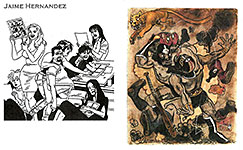 |
||||||||||||||||||||||
Opus 359 (November 5, 2016). $ubscribers will presumably uncoil this scroll just before Election Day, so we’ve taken our last chance at ridiculing and ranting about the fraudulent cheat running for the White House (we mean the Trumpet, the only candidate to meet those criteria) by sampling some of the best editoons of recent weeks. But most of this opus is devoted to a report on the October 13-17 Cartoon Crossroads Columbus festival, among the newest—and certainly the most distinctive—comic cons now raging across the country, one with a distinguished list of guest speakers, including Garry Trudeau (who doesn’t often make such appearances), Sergio Aragones, Lalo Alcaraz, Anne Telnaes, Keith Knight, Raina Telgemeier, Charles Burns, John Canemaker, Ed Koren —to name a few. And it’s free. We also report on Wonder Woman’s new status, Stan on Parade, Bone’s 25th, and review comic book first issues— Moonshine, Cage, Shipwreck, Midnighter and Apollo—and books (Chrislip’s The Minicomix Revolution 1969-89, Your Brain on Latino Comics), plus the wit and wisdom of Trumpkins, who believe the Election is rigged but vote anyhow. How sensible is that? Here’s what’s here, in order, by department—:
NOUS R US The Trial of Mike Diana The Wonder of It All: Wonder Woman Most Powerful Wonder Woman Stamp Wonder Woman at UN MetLife Sheds Snoopy How Long the Simpsons? Jack Chick, Religious Pornographer Dead at 92 Stan on Parade Odds & Addenda Dahmer Movie
FUNNYBOOK FAN FARE Reviews of First Issues of—: Moonshine Cage Shipwreck Midnighter and Apollo
NEW COMIC-CON: Cartoon Crossroads Columbus Over 2,000 Attend the Second CXC: A Report on Events, Day by Day
Bone’s Twenty-Five
EDITOONERY A Review Some of the Month’s Best Editorial Cartoons
THE WIT AND WISDOM OF TRUMPKINS: Part One What the Ravening Mob is Thinking and Saying
NEWSPAPER COMICS PAGE VIGIL Noting the Foolishnesses in the Funnies
THE WIT AND WISDOM OF TRUMPKINS: Part Two
BOOK MARQUEE Short Reviews of—: The Minicomix Revolution 1969-1989 Your Brain on Latino Comics Latinix Comic Book Storytelling The Best American Comics 2016
Onward, The Spreading Punditry Rigging an Election Why Hillary
QUOTE OF THE MONTH If Not of A Lifetime “Goddamn it, you’ve got to be kind.”—Kurt Vonnegut
Our Motto: It takes all kinds. Live and let live. Wear glasses if you need ’em. But it’s hard to live by this axiom in the Age of Tea Baggers, so we’ve added another motto:. Seven days without comics makes one weak. (You can’t have too many mottos.)
And our customary reminder: don’t forget to activate the “Bathroom Button” by clicking on the “print friendly version” so you can print off a copy of just this installment for reading later, at your leisure while enthroned. Without further adieu, then, here we go—:
NOUS R US Some of All the News That Gives Us Fits
THE TRIAL OF MIKE DIANA By Maren Williams, Comic Book Legal Defense Fund Over two decades after Boiled Angel comix creator Mike Diana became the first and only U.S. artist ever convicted of obscenity, an upcoming documentary aims to tell his story. Directed by cult filmmaker Frank Henenlotter and funded in part by a Kickstarter campaign, The Trial of Mike Diana will explore the often subjective standards of obscenity and the intense backlash that can result from what are after all “only lines on paper.” There is no question that Mike Diana’s work, influenced by surrealist art as well as underground and horror comics, is well out of the mainstream — which is precisely the sort of content that CBLDF was founded to defend in 1986, after the police raid of Chicago-area Friendly Frank’s comic shop and the arrest of store manager Michael Correa. Like
the underground comix by Denis Kitchen, Robert Crumb, and others seized
in that raid, Diana’s Boiled Angel featured nudity and sexuality, but
also extreme violence, including mutilation, rape, and child molestation, as
well as taboo subjects such as necrophilia and cannibalism. Diana came to the FBI’s attention in 1991 after some issues of Boiled Angel were found in the possession of Danny Rolling, then under investigation for the serial murders of five college students in Gainesville, Florida. Rolling acted alone and would later plead guilty in 1994 before being executed in 2006, but investigators apparently thought Diana could have been an accomplice based on no evidence apart from Boiled Angel. He was cleared of involvement in the murders after providing a blood sample, but the FBI turned his work over to local police in Pinellas County, who then charged him with obscenity. This is where CBLDF came in, financing Diana’s defense by local attorney Luke Lirot. Despite Lirot’s valiant efforts and the fact that Boiled Angel did not meet the definition of obscenity as laid out in the three-pronged Miller Test, Diana was convicted and received a fine of $3,000, as well as a sentence of three years’ probation, which included stipulations that he stay away from minors and refrain from drawing. He found this last condition to be untenable, later admitting that he hid works-in-progress in the trunk of his car in case of surprise police checks on his home. The upcoming documentary, which the filmmakers hope to have ready for the festival circuit in early 2017, will include original animation by Diana himself. The film will feature interviews with several key players from the trial and the surrounding spectacle, as well as commentary on Diana’s case and his art from a slate of industry experts including Neil Gaiman, who was inspired to join CBLDF’s board of directors after witnessing this miscarriage of justice. Filming of The Trial of Mike Diana is nearly complete, but supporters can still contribute to a Kickstarter to help with post-production expenses including art editing, an original score, and a full legal review. We’re thrilled to see this project come to fruition!
THE WONDER OF IT ALL Benedict
Cumberbatch made the cover of October 21/28's Entertainment Weekly as
Doctor Strange, eponymous protagonist of Marvel Studio’s new film (out November
4), but the Sorcerer Supreme ranks only 26 in the cover story’s list of “The 50
Most Powerful Superheroes.” No surprise perhaps, but Superman is merely 4th on the list. The surprise is Number One: topping the list by three-tenths of a
point is Wonder Woman. Then, in order, the rest of the top ten—Spider-Man,
Batman, Superman, Wolverine, Iron Man, Captain America, The Hulk, Black
Panther, and The Flash. To find the fifty most powerful of the skin-tights, the editors of EW devised a 100-point system that rated each character in nine categories: Cultural Impact, Bankability, Design, Modern Relevance, Mythology, Nemeses, Originality, Personality, and Powers. Each category was worth a maximum of 10 points except Cultural Impact: “The power of a superhero is defined most by this quality, so we measured it on a 20-point scale to tilt the final list in favor of characters who have the deepest cultural footprint.” The editors then assembled “a team of EW’s superhero experts and had them score 155 characters in each category.” Those scores were averaged and combined to create “an overall power total for each character.” Wonder Woman scored 90.3 out of a possible 100. Spider-Man scored 90.0; Batman, 89.7; Superman, 87.2. Wonder Woman, Batman, and Superman each scored 20 in the Cultural Impact category; Spider-Man, only 18. Wonder Woman rated only 9.3 in Bankability; the other top four each got 10 points. Superman ranked highest in Powers (9.7 out of a possible 10), Spider-Man in Personality (9.7), Wonder Woman in Originality (9.3—ahhh, William Marston’s juicy menage a trois scores again), Batman in Nemeses (10, thanks to the Joker, no doubt) and Mythology (9.7), Wonder Woman and Batman in Modern Relevance (10 each), Batman in Design (9.3; Wonder Woman scored only 8.3; Superman, a mere 7.3). Wonder Woman ranked first in only three categories; Batman scored highest in five (Spider-Man in two, and Superman in three). So how did Wonder Woman win? Probably because she scored so high in Originality—9.3 compared to the next highest, 8.0 for both Batman and Superman; that’s 1.3 points higher than her closest competitors in that category. How come Superman, who started all the superheroing in funnybooks, didn’t rate a pioneering 10 points for Originality? Dunno. Looks rigged to me. Wonder Woman won by only 0.3 more than Spider-Man, who was second. A cursory count gives Marvel 33 of the 50 characters; three of the remaining 17 are from publishers other than the Big Two (Hellboy, Buffy, and Raphael of the Ninja Turtles), leaving DC with only 14 of the top 50. Clearly, EW’s “superhero experts” are of the generation that was mesmerized by Marvel funnybook characters in the sixties and seventies or by the Marvel Studio movies of the last decade or so. Oh—and most of the top-ranked superheroes derive their rank as movie stars not four-color fabrications. That figures: EW didn’t (and doesn’t) pay attention to funnybooks; just movies. The article, which runs for 40 pages, is illustrated with some of the most imaginative visual interpretations. The Invisible Woman, for instance, appears as a connect-the-dots diagram. Most of the characters show up as their movie incarnations, but Robin is a series of drawings, suggesting his frequent transmogrification. Emma Frost arrives in white underwear and garter belt. Deadpool is illustrated by a comic strip in which the Motormouth is told he isn’t Number One on the list. But when he finds out Wonder Woman is, he murmurs: “You know, a hot chick with a lasso of truth totally gets my motor running. Nice going, Pervs.” Some interesting side-bars intrude. “Worst Potential Room-mates,” f’instance. (The Hulk tops the list.) And midway through the article, we meet “The Greatest Villains of All Time”: in order, beginning with the “worst,” Magneto, the Joker, Kingpin, Doctor Doom, Catwoman, Loki, Ozymandias, Venom, Galactus and Dark Phoenix. Here’s the whole list with a few oddities and a couple of the illustrations that enliven the article.
Deadpool didn’t make the top ten; he’s 12th. The Thing, once a fan favorite, stands at 24. Captain Marvel at 27 is Marvel’s character (originally Carol Danvers), not Fawcett’s, although the write-up acknowledges that the Fawcett incarnation was a “blockbuster Superman knockoff” (the “knockoff” attribute is debatable here at Rancid Raves) and rates the DC re-incarnation, Shazam, at 47. Luke Cage, a recently revived phenomenon, stands at 29; Hellboy, one of the three characters not published by the Big Two, at 32; Buffy is 11th and Raphael is 21st. I was surprised to see Raphael on the list at all; ditto Nightcrawler. But then, nobody ever tells me anything.
THE STAMP OF WONDER
A MISGUIDED WONDER What with all the folderol—including, not at all incidentally, a motion picture with the Amazon princess in the title role (due next summer)—Wonder Woman is having her best year yet. And it’s her 75th anniversary year, too. (So it took 75 years for her to get up on the Big Screen all by herself?) But the icing on the cake took place Friday, October 21 (her formally-designated birthday), when she was officially installed as the United Nation’s honorary ambassador for the empowerment of women and girls and for gender equality, a.k.a. Goal 5 of the UN’s Sustainable Development Goals: 17 Goals to Transform Our World. She will appear in a social media campaign and other initiatives. The installation took place at the United Nations in the Economic and Social Council chamber, and special guest list included Diane Nelson, president of DC Entertainment; Lynda Carter, who embodied the comic book character in the 1970s television series; Gal Gadot, who has taken on the role in the forthcoming Wonder Woman film; and the United Nations secretary general, Ban Ki-moon. Alas, joy did not reign in Mudville—or anywhere else in the land from sea to shining sea. The UN staff, reported Somini Sengupta at the New York Times —some 600 of them—signed “an online petition calling on Secretary General Ban Ki-moon, a professed feminist, to reconsider the appointment of the fictitious superhero as its ambassador for women’s empowerment.” Some objected to picking a comics character, but that’s been done before: earlier this year, Red from Angry Birds become honorary ambassador for the International Day of Happiness. All honorary ambassadors are fictional characters, so the association with the comics wasn’t the problem. On one level, wrote Vanessa Friedman at nytimes.com, the appointment “makes sense. Wonder Woman is the epitome of the woman who needs a man the way a fish needs a bicycle. (She appeared twice on the cover of Ms. magazine.) She is self-sufficient and strong and fights for equality and justice. She is not derivative of a male character the way Supergirl or Batgirl is, and she does not disguise herself as Catwoman does. In the new Wonder Woman movie, she says to her male co-star, ‘What I do is not up to you.’” The source of the petitioners’ ire is the appearance of Wonder Woman. “The issue,” Friedman said, is “that Wonder Woman does most of her power work in a star-spangled strapless bathing suit and knee-high boots, with a healthy amount of cleavage and leg on display.” Or, as the petition puts it, “a large-breasted white woman of impossible proportions, scantily clad in a shimmery, thigh-baring body suit with an American flag motif and knee-high boots” is not an appropriate spokeswoman for gender equity at the United Nations. Friedman continues: “In the era of Donald J. Trump, when the issue of objectifying women because of how they look is foremost in every conversation, the outfit issue — and the related body image issue — cannot be so easily dismissed.” The selection of Wonder Woman was “particularly ill-timed,” said Sengupta, “because the United Nations this month rejected seven female candidates for secretary general. The next leader will be António Guterres of Portugal, even though many had hoped a woman would take the helm for the first time.” “The message the United Nations is sending to the world with this appointment is extremely disappointing,” the petition reads. “The bottom line appears to be that the United Nations was unable to find a real-life woman that would be able to champion the rights of ALL women on the issue of gender equality and the fight for their empowerment. The United Nations has decided that Wonder Woman is the role model that women and girls all around the world should look up to.” “On the one hand,” said Friedman, “allowing girls to revel in their physicality and femininity is a good thing. I am not saying they should dress like nuns or adopt a pantsuits ‘r’ us mentality. They should own their womanhood and all that is special and different about it. You can argue that refusing to apologize for or hide your body under a sackcloth is a feminist act. But most women, I would guess, would not choose to display their allure while wearing a star-spangled maillot and cape, which is to say an outfit that no one could actually wear to work, unless she were working as the impersonator of a comic book character.” Friedman reported that Lynn Carter, who appeared as President in a recent “Supergirl” episode, wore “a long baby-blue jacket, skinny black trousers and pumps. ‘Smart, strong, easy, comfortable,’ Carter said of the look, adding that she based it on Hillary Clinton and the House minority leader, Nancy Pelosi. “Power dressing does not have to mean dressing like a man,” Friedman went on, “but it also does not have to mean dressing like a clichéd male wet dream.” She acknowledges, however, that “like most superheroes, Wonder Woman is inseparable from her clothing: It is her immediate signifier, the representation of all about her that is special and unique (and kick-butt). And that clothing unavoidably indicates to everyone that part of the source of her power is her babeliciousness, as defined in a particularly retrograde way.” When asked if the United Nations had thought about a wardrobe overhaul, Maher Nasser, UN’s director of Outreach in Public Relations, said, “The key art that was developed with the campaign does reflect many of the observations and comments that we have provided,” but he declined to be more specific. A spokeswoman for DC Entertainment used words like “regal” and “appropriate” when discussing how Wonder Woman would look in her United Nations appearances, and added that the campaign was drawn by Nicola Scott, the artist behind the current incarnation of the comic book Wonder Woman. “The goal was to create a noble and strong look, while still maintaining Wonder Woman’s approachability and global appeal,” Scott said. “I put considerable effort into ensuring her eyes were powerful and conveyed her characteristics of peace, justice and equality.” Admittedly, Wonder Woman in any role intended to speak of women as people rather than as sex objects is a problem. But the problem began long ago—with the division of the human species into two sexes. All superheroes in funnybooks wear skin-tight costumes, men as well as women. And I’m sure women readers find male superbeings as sexually attractive as men find female superbeings in comic books. Moreover, Wonder Woman is scarcely the only superheroine to show a lot of skin as well as physical skill. I don’t think we can escape the predicament altogether. Not as long as humanity is bisexual. But there is a matter of time and place. And I agree that Wonder Woman in her scanty underwear doesn’t belong on a serious mission for the UN. Friedman, too, wonders about the message Wonder Woman sends “about female empowerment to our daughters in an era when there are a number of fully clothed, notably powerful female role models?” And she goes on with a perfectly acceptable suggestion: “Certainly, fashion, which is not ignorant of the rise of the power woman, and the industry’s role in determining what she might look like, has come up with a lot of options, from the C-suite sheath to the swishy suit to the athleisure power duo of leggings and Lycra. I imagine Donatella Versace, Stella McCartney and Diane von Furstenberg (who actually released her own Wonder Woman book in support of the nonprofit Vital Voices in 2008), to name a few, would have some ideas about what becomes a modern female superhero. That’s something I would love to see.” Me, too.
BADINAGE AND BAGATELLES The Trumpet continues to work hard at alienating those he needs if he wants to win this election. The Republicon establishment’s current and growing antipathy towards him is part of a larger conspiracy, he has asserted: “There’s a whole deal going on—we’re going to figure it out. I always figure things out. But there’s a whole sinister deal going on.” In Ohio, a battleground state that Trump must win, he has cut ties with the chairman of the state GOP party, Matt Borges, because he, Trump, doesn’t like Borges’ expressions of disappointment with Trump’s behavior. Longtime GOP strategist Curt Steiner said: “The Trump campaign is silly to focus its attention on inside baseball about the Ohio Republican Party. I thought Trump was trying to defeat Hillary Clinton, not Matt Borges.” At this rate, the Trumpet will achieve the standing he most ridicules—that of “loser.”
METLIFE SHEDS SNOOPY When MetLife adopted Snoopy as a symbol in 1985, it did so because it wanted to appear friendly and approachable, which was hard to do at a time when people thought “death benefits” and “beneficiaries” were synonymous with life insurance. Life insurance companies were seen as cold and indifferent. But Snoopy was cuddly and approachable, thanks to Charles Schulz, so the beagle provided the warm and fuzzy that helped with MetLife’s image. These days, people no longer have a negative view of life insurance, and the company wants to brand itself in a way that opens doors internationally. Snoopy, despite his worldwide fame, apparently wouldn’t do for the new MetLife. So Snoopy is being retired from appearing in the giant insurance company’s print ads, TV commercials, marketing materials and on the sides of MetLife’s blimps at sports events. “No more big-nosed beagle in the flight cap and goggles chasing the Red Baron on Metlife’s airship,” write Christine Hauser and Sapna Maheshwari in the New York Times. “No more television commercials featuring a smiling Snoopy navigating life’s treacherous waters to sell insurance. Cuddly Snoopy hitting a home run? Out.” The move, saith MetLife, is part of an effort to update its corporate emblem for international competition. The company called the decision the “most significant change” to the brand in decades. MetLife researched its decision before putting it into effect. Consumers thought the Peanuts characters were friendly and approachable, but did not associate them with traits like leadership and responsibility. Nor did the characters affect interest in buying insurance. Besides, the company research determined that most people are “indifferent” to having Snoopy disappear from MetLife ads. Instead, I gather from the Times article, the company’s emblem will be a giant M formed by overlapping pizza-like slices, one in blue the other in green, colors that “represent life, renewal and energy.”
WHITHER THE SIMPSONS? On Sunday, October 16, “The Simpsons celebrated its 600th episode, just 35 airings shy of the record for the most episodes of an American scripted prime-time show held by “Gunsmoke.” And this achievement prompted Michael Cavna at ComicRiffs.com to wonder: so when is the show finally going to ride off into the Springfield sunset? “Never!” replies a laughing David Silverman, the longtime “Simpsons” producer who has been there since the very beginning, animating the interstitial shorts when the Simpsons debuted in 1987 on “The Tracey Ullman Show.” “We don’t want it to end,” he says. ‘Keep it going!’ 600? I say: ‘1,000! Do I hear 2,000!'” For the sake of comparison, as well as inspiration, Silverman cites the run of Looney Tunes, the classic animated comedy shorts from Warner Bros that spanned 1930 to 1969. “It wasn’t that they were running out of ideas, per se,” says Silverman, citing Tex Avery’s Oscar-nominated “A Wild Hare” (1940) as the pinnacle of Looney Tunes animation. “They just ran out of a delivery system.” The Warner Bros. Cartoons studio closed as the ’70s dawned, marking the end of the “golden age” of animation. “For ‘The Simpsons,’ so far, we haven’t run out of the delivery system,” notes Silverman, whose show holds the record for most seasons (27) of an American scripted prime-time show, with the renewal already announced for season 28.“I don’t know what’s going to happen to the future of home entertainment,” he continues, “but I think there’s always going to be some aspect of the big TV screen.” “I don’t know why you’d stop it,” says Silverman of “The Simpsons,” which was co-created by Matt Groening, James L. Brooks and the late Sam Simon. “We’re having a great time.”
RELIGIOUS PORNOGRAPHER DEAD AT 92 Jack Chick who made a living for half-a-century selling and distributing religious comic booklets of 24 pages each (which you could buy for 13 cents) died October 23. His tracts have been described variously as “sanctimonious hate literature,” “hardcore Protestant pornography,” and “pure spiritual sadomasochistic fantasy.” Normally, we’d have a piece about Chick in our Passing Through obituary department, but I want to research his life a little, and I don’t have time to do that and get this opus into the digital ether. Why do I want to research the life and career of a religious zealot? Not being a zealot myself (or even religious in the usual sense), what could possibly be the attraction? Because Chick was more than a religious nut (although he was that): he was a comics artist and writer who (it isn’t too much to say) pioneered self-publishing with greater success than anyone before or after him. Worth a longer look than we have time for this time.
STAN ON PARADE “His name is
the first name you think of when you think of Marvel”—an undeniable truth, no
doubt. But for all his fame, Stan Lee hasn’t, until lately, been on the
cover of Parade, the newspaper Sunday supplement. “Every day is a new adventure,” Lee says, and he’s never gone dry. “You can’t run out of ideas. You look at anything, you get an idea. I look at that telephone. If I look at it long enough, I’ll think of a story.” Lee has become such a celebrity that 20th Century Fox recently announced the purchase of the rights to make an “adventure movie” about his life. But Lee doesn’t live in the past, and while he doesn’t mind talking about his many creations, he’s much more interested in what’s coming next. For instance, when asked about what superpower he would most like to possess, he says “luck,” and immediately launches into talk about the show airing on British television called Stan Lee’s Lucky Man, which he says will be adapted for American TV sometime soon. ... Last summer, Lee unveiled Nitron, a new comic-book character franchise targeted at feature films, TV and digital platforms, and launched Stan Lee’s Cosmic Crusaders, an animated online series in partnership with the Hollywood Reporter and Genius Brands International, in which a version of himself makes regular appearances. When asked which three of his superheroes he would like to have dinner with, he takes a moment to think the question through. “I’d probably enjoy talking to Iron Man,” he says. “I’d like to talk to Doctor Strange. I like the Silver Surfer. Iron Man is sort of a classier Donald Trump, if you can imagine that sort of thing. The Silver Surfer is always philosophical; he comments about the world and man’s position in the universe, why we don’t enjoy living on this wonderful planet and why we don’t help each other. “But I only wrote about these characters fighting and having problems. I never really did many episodes where they were eating, so I don’t even know how their table manners are.” To Lee, his characters are real, and that’s the way he wrote them, with human foibles and frailties. He learned how from his youthful passion for reading. In his working-class upbringing in New York City, reading offered him both escape and something to reach for. Charles Dickens was a particular favorite, as were tales of adventure and derring-do. “I wanted to be like the Scarlet Pimpernel,” he says. “I wanted to be like Tarzan.” He remembers the personal connection he felt when he read the Jerry Todd and Poppy Ott books, precursors to the Hardy Boys series, featuring young detectives and a message from the author on each closing page. “I loved that,” he says, and he remembered that feeling when he became a comic-book editor years later. “I wanted the readers to feel as if we’re friends. I did the Stan’s Soap Box column, just so the readers would get to know me. “One thing I did, I used college-level vocabulary. I didn’t worry that young kids were reading the story. I felt they’ll know what I’m saying by the use in the sentence, and if they have to go to a dictionary, that’s not the worst thing in the world. “A lot of people that I meet now, older people, have said to me, ‘We love the fact that when we read the comics as a kid, they weren’t written for children only.’” ... Lee’s savvy approach to his readership has paid off handsomely in the long run. “Some little kid, 5 years old, will walk over to me and say, ‘I’m your biggest fan.’ College kids [ask], ‘Would you mind posing for a picture?’ Men in their 60s and even older say, ‘I want to thank you for making my childhood so pleasant,’ or ‘for giving me an attitude about life.’ I mean, you’d think I was writing books of philosophy,” Lee says. “And the old comic books that I wrote a long time ago sell for a hell of a lot of money!” No wonder he can still keep those ideas coming and keep his superpowers focused on the next superproject. Fitnoot: I’ve never heard of Nitron, and I suspect that many of Lee’s newest ideas for comic books and superheroes are so rooted in the past and the cultural milieu of the 1960s and 1970s that they’ll never be taken to the hearts of 2016 fans.—RCH, the old wet blanket his ownself.
ODDS & ADDENDA John “Derf” Backderf, whose graphic novel Trashed we reviewed in Opus 349, is best known, doubtless, for another graphic novel, a horror tract about a real-life classmate of Derf’s, My Friend Dahmer, a rapist, a murderer, and a cannibal who attracted national renown in 1978-9. Dahmer is on the cusp of becoming a major motion picture, sez here (Columbus Alive, October 13).
Fascinating Footnit. Much of the news retailed in the foregoing segment is culled from articles eventually indexed at rpi.edu/~bulloj/comxbib.html, the Comics Research Bibliography, maintained by Michael Rhode and John Bullough, which covers comic books, comic strips, animation, caricature, cartoons, bandes dessinees and related topics. It also provides links to numerous other sites that delve deeply into cartooning topics. For even more comics news, consult these four other sites: Mark Evanier’s povonline.com, Alan Gardner’s DailyCartoonist.com, Tom Spurgeon’s comicsreporter.com, and Michael Cavna at voices.washingtonpost.com./comic-riffs . For delving into the history of our beloved medium, you can’t go wrong by visiting Allan Holtz’s strippersguide.blogspot.com, where Allan regularly posts rare findings from his forays into the vast reaches of newspaper microfilm files hither and yon.
FURTHER ADO What Goes Around, Comes Around. One of the Cutthroat CalipHATE’s first reforms after capturing a territory is to require adult women to dress devoutly—including the face-covering burka robe, which, in Western democracies famously presents security dilemmas because it hinders identification. Now, after two years of Cutthroat occupation in Mosul, Iraq, the security problem has come full circle. Dispatches from the town reported that the CalipHATE rulers have likely banned the burka because it hinders identification of anti-CalipHATE insurgents who (female and male) wear burkas to sneak up on Cutthroaters. (I’m quoting a source verbatim but I’m quoting from a clipping and can’t identify the actual source.)
FUNNYBOOK FAN FARE Four-color Frolics An admirable first issue must, above all else, contain such matter as will compel a reader to buy the second issue. At the same time, while provoking curiosity through mysteriousness, a good first issue must avoid being so mysterious as to be cryptic or incomprehensible. And, thirdly, it should introduce the title’s principals, preferably in a way that makes us care about them. Fourth, a first issue should include a complete “episode”—that is, something should happen, a crisis of some kind, which is resolved by the end of the issue, without, at the same time, detracting from the cliffhanger aspect of the effort that will compel us to buy the next issue. A completed episode displays decisive action or attitude, telling us that the book’s creators can manage their medium.
IN MOONSHINE, Brian Azzarello and Eduardo Risso are back, and together they start us off with a brilliant stark cover on which a trio of armed men are silhouetted against the moon. They are federal agents assigned to find and destroy a liquor distillery in the backwoods of West Virginia in 1929. But as soon as they find the still, they are destroyed, torn to bits with gun fire. The scene then abruptly shifts to a city somewhere, and we meet Lou Pirlo in a shabby rooming house and, shortly, his boss, a crime kingpin named Joe Masseria, who has discovered an excellent booze manufactured somewhere in West Virginia; he sends Pirlo to find the man who made the booze, Hiram Holt, and to offer him a deal whereby Masseria will market Holt’s product. We don’t actually see Pirlo until he arrives at a little town where Holt lives: during his encounter with his boss Masseria, Risso keeps Pirlo’s face hidden. And when we get to see him, turns out he’s a handsome dog, and he eyes a couple of girls in the restaurant, leering suggestively at them. That’s a mistake: they’re Holt girls, he finds out. So nothing comes of that short but completed episode except that we see one of Pirlo’s unsavory sides. Pirlo meets Holt and offers him Masseria’s deal. Holt thinks, correctly probably, that Masseria is trying to screw him, so in the book’s second completed epiosode, he takes Pirlo to the still that is the scene of the slaughter that opens this issue. The blasted bodies of the agents are still there—a message Holt wants Pirlo to deliver to Masseria: “These are my mountains,” he says, “and this is what happens to dumb shits wanna fuck with my business.” Pirlo is escorted to his car, and he takes off. But he gets a flat tire, and when he goes to find help, he chances upon a party in the wooded night, a bunch of black people dancing. And his last act in this issue is to leer at one of the black women, a cliffhanger ending that suggests Pirlo is about to rape someone. As always, Risso’s visualizations are brilliant, often steeped in deep shadowy atmospheric black, and the page layouts, as usual, are inventive. Typically, on each page several narrative panels are clustered around a single large panel that sets and sustains the locale of the narrative smaller panels—as we see near here, where we’ve posted several pages from this stunning first issue.
WE CAN TELL FROM THE COVER that Marvel’s latest reincarnation of Luke Cage, “Power Man,” in the monosyllabic title Cage is not the typical Marvel superhero funnybook. Its arrival coincides with the advent of Netflix’s tv series, but the print version of Luke Cage, written and penciled by Genndy Tartakovsky, is nothing like the Mike Colter version: this is a spritely, clunking comical composition the bold lines and exaggerated anatomy of which suggest not only power but a bigfoot element of playfulness. In the opening sequence, Cage stops some bank robbers by beating them up. As the cops arrive, he leaves the scene of his apprehension and joins some neighborhood kids playing basketball. He plays so powerfully that he destroys the hoop. Then he goes to keep an appointment with Misty Knight. He’s late, and she’s later. In fact, she doesn’t show up at all, so Cage goes to her office at the local police station. There, he persuades a petty crook momentarily behind bars (and then not) to tell him that Misty split when all the superheroes left town. Cage goes to Misty’s apartment where he finds some X-men (Cyclops, Wolverine and Nightcrawler), who’ve come there looking for Jean Grey, and Cyclops knocks Cage out of the building with a blast from his eyeballs. Upon landing, Cage’s body plunges into the earth several inches, and as he lies there, a quartet of comically exaggerated supervillains (The X Chemistro, Mace, Mr. Fisher, and a fat lady named Black Mariah) engage him in battle, but, outnumbered and nearly squashed when the fat lady lands on him (her weight being her superpower), he prudently races off, and then, suddenly—out of nowhere—a fist arrives on his jaw that knocks him out, leaving us dangling as to whom the fist belongs. No complexity encumbers Tartakovsky’s story: it’s an old fashioned quest tricked out with numerous fight scenes.
Every fight is a completed episode, revealing the extremes to which Tartakovsky takes both the narrative and the visuals: Tartakovsky’s style is a broad adaptation of vintage Harvey Kurtzman, and the story could almost have come out of Mad. It’s an energetic gas, frothing with fun-loving exuberance (to the extent of actually ridiculing superhero comics), and I can’t wait to see how long Marvel will let Tartakovsky have his way with Luke Cage. At least up to No.4, the end of this series; but I wish it would last longer.
WARREN ELLIS’s Shipwreck is brilliantly brought to life by Phil Hester, drawing in an advanced manifestation of his earlier crisply blacked style: here, angular shapes are formed with slender lines and chips and swatches of black. Eric Gapstur inked Hester—beautifully; and Mark Englert colored the book in a manner that compliments the rendering style with chips and swatches of hues of the basic colors. Ellis’s story, however, is just a shade too mysterious. I allow that mystery is at the heart of the tale. We learn from an “inspector” interrogating the protagonist, Dr. Johnathan Shipwright, that the good doctor was a civilian scientist working on a U.S. Air Force secret project, Janus, which crashed with Shipwright the only survivor. He believes the project was sabotaged, and he’s in search of the culprit. That’s the mystery—a quest—that’s the macguffin of the story. And the encounter of Shipwright and the inspector is the first completed episode in the issue; it sets up the plot, “explains” Shipwright and portrays him as a driven, tormented soul. But Ellis has festooned his simple macguffin with a host of unexplained encumbrances. When we first see Shipwright as the book opens, he’s on his back, wrapped in bandages like a mummy, and being pestered by a flock of birds (which, Ellis later hints, may be elements of an augury, an ancient ceremony involving bird flights and their songs as hints of a future). The first five pages are absolutely silent. Shipwright wanders off, perhaps following the birds, and finds himself in a diner being interviewed by the self-proclaimed “inspector,” whose questions clue us in to the mystery and who tells Shipwright he’s “walking in the right direction” to find the saboteur. At this point, Shipwright wonders why no one in the diner has arrived to take their order. He approaches the doors to the kitchen and, finding them locked, transports himself through them to the inside, where he finds a woman, splattered in blood, cooking human body parts, eyeballs floating in a frying pan. Beneath the butcher’s block a bleeding man crouches on all fours, two cleavers buried in his back, his eye sockets black holes. The woman speaks threateningly to Shipwright, and he defends himself with a broomstick, inadvertently knocking the woman over, and when she falls, she lands on a spike-like kitchen tool that drives through her head from side to side. Shipwright recoils in horror at the sights before him— her corpse and the bleeding man on all fours— and he flees the kitchen, ending the second completed episode, showing Shipwright to be resourceful even if he isn’t looking for trouble and tries to avoid it. Out in the dining room, the inspector has departed, leaving a note behind: “There is a rescue mission.” Shipwright leaves the diner and resumes walking along the road, followed by a flock of birds, silhouetted black against the sky. End of issue. Oh, yes—and spiders have begun to swarm even before Shipwright leaves the inspector to visit the kitchen. While the nature of Shipwright’s quest and the plot function of the inspector are reasonable enough to get the mystery going, the cook and her victim in the kitchen seems a detour not worth taking. And the spiders? But Ellis is good. And Hester’s masterful artwork is worth looking at again and again. So I’ll be back—to enjoy Hester and to see how Ellis rescues his story by making all the silent symbols work together.
MIDNIGHTER AND APOLLO is about a pair of gay superheroes, and that seems to be the most discernible of its purposes. The rest of the first issue is about bloody brutality and fraught implications for a plot that never breaks the surface. No.1 opens with Midnighter destroying, virtually bare-handed—and grinning fiendishly all the time— a trainload of “the worst murder boys to ever kiss the third rail.” Once that’s over, Apollo destroys the train. The train and the guy who bosses the baddies, Half-Beard (who shaves only half his face), are not explained: I’d say the explanation took place in a previous issue, but this issue is No.1 so there is no previous issue. Our dashing duo rescue some children that Half-Beard has kidnapped. End of adventure. Then Midnighter and Apollo have friends over for dinner, engage in lively table talk, and then, after the friends have left, strip their clothes off and make gay love.
Male and female superheroes have increasingly been depicted in bed before and after copulation, but never, to my knowledge, gay males. Or gay females. Or transpersons. The two-page sequence of domesticity that follows the opening sequence of Midnighter getting bloody by killing people is, I ween, a first in American comic books. Unusual though that may be, it doesn’t upset me at all. Surprises me, yes; but no consternation. What bothers me about this book is Midnighter’s “superpower”: he’s been programmed to kill people, people who he mysteriously knows are bad guys. And he sometimes kills them brutally albeit picturesquely. Apollo is a “solar-powered alien experiment” of great power. He throws trains around. But Midnighter kills people. Without compunction. After they make love, Apollo implies that he wants to “help” Midnighter somehow “get over” his killing impulses. But Midnighter has the last word: “If there’s one thing I know, some people just need to be killed.” So ends the most complete of the episodes in the book. In this issue, the stark contrast between Midnighter’s murderous inclination and the lovers’ tender regard for each other is jolting in its incongruity. Apart from that, writer Steve Orlando fails to conjure up a cohesive story. The villain is Henry Bendix, the man who made Midnighter what he is. And Bendix is launching into some kind of world-threatening scheme (which is not clearly specified; it may be simple robbery). Midnighter finally tracks Bendix to his lair, and at the very moment of their confrontation, the narrative shifts to Apollo’s current battle with what seems to be a nasty-looking giant bug, who hasn’t appeared in these pages before. Midnighter seems to envision the encounter as its happening and wishes Apollo weren’t doing what he’s doing. After the battle, Apollo is left in a fetal position, whimpering, with a black-hooded character standing over him. Midnighter is still facing Bendix but they’ve been left far behind. Fernando Blanco does a thoroughly credible job drawing Orlando’s meaningless story, and colorist Romulo Fajardo splatters blood all over everyone whenever necessary. But aside from the “sensation” of depicting gay men before and after moments of conjugal bliss, this book seems to serve no useful purpose. And the murderousness of one of its protagonists is distasteful in the extreme. I won’t be back.
QUOTES & MOTS From AARP Bulletin, October 2016—: Discussing the latest Obamacare fate with three giant insurers leaving the exchanges, Sabrina Corlette, research professor at Georgetown University’s Health Policy Institute, said: “This is very much a market still in flux, and insurance companies are still trying to figure out how to make it a viable line of business,” but “structurally, it’s sound.” According to Katherine Hempstead, senior program officer of the Robert Wood Johnson Foundation: “It’s not a question of failure. It’s when will it improve, and how will it improve?
YET ANOTHER COMIC-CON. NOT QUITE. MORE THAN THAT. CXC = Cartoon Crossroads Columbus JUST THINK OF IT: a comic-con without movie or television stars. No Hollywood. No gaming. No cosplay. And no superheroes to speak of. What kind of a comic-con is that? It’s a comic-con for people who love comics and the arts of cartooning, that’s what. And it’s all free. That’s right. No charge. Just come to Columbus, Ohio. For four days in Columbus, October 13-16, the CXC organizers’ “mission was to make Columbus the cartooning capital of the world,” saith Tom Spurgeon, Festival Director, in an interview with Tom Hodler in tcj.com in early October this year. Spurgeon was picked for the job after the first “soft launch” of CXC last year. CXC needed a manager. As editor of The Comics Journal 1994-1999, he knew a lot of people in the business, and his connections were valuable. One of the CXC founders, Jeff Smith, was among the first cartoonists Spurgeon interviewed after arriving at the Journal, and Smith reached out to Spurgeon, who moved to Columbus from his hideout in New Mexico where he produced his online ComicsReporter.com. “Festival director,” Spurgeon told Holder, “means I’m primarily responsible for the logistics of it, the making it happen of it. That’s both in just making sure stuff gets set up but also that we’re executing according to our goals and ideals.” Why Columbus? Because the Billy Ireland Cartoon Library & Museum on the campus of the Ohio State University is in Columbus. The Billy Ireland houses the world’s largest collection of original cartoon art and related books, magazines, and newspaper clippings, and the Billy Ireland actively promotes interest and scholarship in the arts of cartooning, staging numerous exhibitions and seminars throughout the year. Falling in line, the Columbus College of Art and Design recently announced the addition to its curriculum of a new Comics & Narrative Practice major. Columbus Alive, a free weekly in town, devoted its October 13 issue to CXC; the coverage began with an article about cartooning in the city, “25 Essential Columbus Comics,” graphic novels and comic books produced by local cartoonists. And Ohio has an ample cartooning history. Hundreds of cartoonists were born in Ohio or spent significant time there. The reputed “father of American newspaper comics,” the Yellow Kid’s Richard Outcault, was born in Ohio. Ditto Billy Ireland, Milton Caniff, and James Thurber; others lived and worked in the state— John “Derf” Backderf, Brian Michael Bendis, Billy DeBeck, Roy Doty, Al Frueh, Cathy Guisewite, Charles Landon, and scores more, from Gene Ahern to Joe Shuster and Jerry Siegel to Bela Zaboly.
The
first two days of the four-day CXC took place at the Billy Ireland, with
programming and special exhibits; the succeeding two days transpired downtown
at the city’s Metropolitan Library, where the CXC Expo opened. Spinning out
from those two sites, the CXC took over the city with special exhibits at
various venues. CXC replaces the triennial festival of cartoon art that was sponsored by the Billy Ireland for many years. The idea of CXC founders Jeff Smith (Bone) and Lucy S. Caswell (curator emeritus of the Billy Ireland) was to make Columbus the Angouleme of America. Like the International Comics Festival in France in January of every year since 1974, CXC would take over the host city. For Jeff Smith, CXC is a dream come true. “I had this idea,” he said, “What if we could bring these artists together on one weekend in Columbus? This isn’t the kind of event where people come dressed up as Captain America (although they’re free to do that if they want to). These artists are people that are working from their own voice.” As Smith did in creating Bone (which, this year, celebrates its 25th anniversary; see down scroll). This year, CXC took over Columbus from Wednesday evening, October 12, with an preamble event, through the following Sunday. And it was free. There’s no registration. No list of attendees. (And people, including Columbus residents, come and go all weekend.) And no head count. Attendance at last year’s “soft launch” was estimated at 600-1,200. With no formal registration required, determining how many people enjoyed this year’s Festival requires looking at several aspects of the event. The scholarly presentations at the Billy Ireland were not counted, Spurgeon told me (I counted about 130 people at one of the second day’s presentations), but Wednesday evening’s screening of Mark Osborne’s “The Little Prince” was estimated at 200 based upon the available seating; similarly, at Thursday evening’s appearance of Garry Trudeau, 750 people filled seats at the Mershon Auditorium. At the Library downtown, Spurgeon said, “we were 2,200 over average attendance on Saturday, and 1,600 on Sunday.” There’s no advance printed promotion. To get yourself oriented, you must start at the website, cartooncrossroadscolumbus.com. The closer CXC came, the more programming popped up on the website. So
before I booked a hotel room and bought my plane ticket, I knew the first
official event was Wednesday evening, and that the programming began Thursday
morning at the Billy Ireland with coffee and pastries at 8 a.m. I showed up
there at 8:30 a.m. and picked up the printed program and a cup of coffee. I was
handed a blank name badge (no preprinted badge with your name; no one knew I
was coming—no registration, remember?) and wrote my name on it (adding, later,
my rabbit, whom I call Cahoots; that’s not his name—his name is Harvey—but I
call him Cahoots anyhow). The program booklet told me about the exhibits all around town—: At the Columbus College of Arts and Design, selected original art provided by Nate Powell from March: Book Three, the final autobiographical volume of Congressman John Lewis’ engagement in the Civil Rights Movement. Powell signed copies of the book on Saturday. At the Columbus Museum of Art, selected original art by artist-in-residence at the Thurber House (where James Thurber grew up), Ronald Wimberly, who appeared on the program on Sunday in conversation with OSU’s Jared Gardner. At the Wild Goose Creative, the Sunday Comix Group presented Comics vs Art: Fine Art Isn’t Just for Adults Anymore, “a show that ‘playfully reimagines fine art as comics panels.’” At OSU’s Barnett Collaboratory, cartoonist Keith Knight and collaborator Matthew Schwarzman appeared in “an evening of ideas, games and live art called Sex, Lies and Social Change: The Roots of Community-Based Arts.” At
the Boat House, the Columbus Metropolitan Club offered a special CXC program
featuring animator Mark Osborne (“Kung Fu Panda,” “The Little Prince”),
editorial cartoonist Nate Beeler (Columbus Dispatch), and
graphic novelist Ronald Wimberly (Prince of Cats). On Friday, the Sol-Con Expo and Workshops was scheduled to take place at OSU’s Hale Hall. This event was founded in California by John Jennings and Ricardo Padilla to foster awareness (among the public and among the affected minorities) of Latino and African American comics and their creators by showcasing their work. Said Jennings, interviewed in Columbus Alive: “Basically, it’s a way to combat symbolic annihilation, which is erasure through omission. It’s a way to empower people who haven’t been able to see themselves in mainstream comics and media.” And at the Billy Ireland, two special displays (in addition to the permanent exhibit): Good Grief: Children and Comics, which examines “the history, role and tensions of child characters in comic strips and comic books”; and Little Nemo: Dream Another Dream, which combines original art from the Nemo tribute book of the same name with resources from the Billy Ireland’s extensive collection of Winsor McCay material. And on Friday, an Open House offered special tours of the facility (leaving every hour) and a display of some of its treasures in the Reading Room. The program booklet also listed (and annotated) the CXC special guests, who would be making presentations throughout the weekend: cartooning legends like Garry Trudeau, Sergio Aragones, Ben Katchor, Ed Koren, Carol Tyler, Stan Sakai, John Canemaker, Seth; modern stars Raina Telgemeier, Brandon Graham, Julia Gfrorer, Jay Hosler, Mark Osborne, Sacha Mardou, Skottie Young, Ronald Wimberly; skilled practitioners of their craft like editoonists Ann Telnaes and Nate Beeler, satirists Keith Knight, Lalo Alcaraz, Charles Burns. All of whom made presentations throughout the weekend.
THURSDAY The presentations began Thursday morning at the Billy Ireland with the first of the two day-long scholarly symposium featuring about three dozen presentations, all gathered under the umbrella heading “Canon Fodder!” Probably few (if any) of the presenters started out with that topic in mind; it was doubtless conjured up to be broad enough to include all sorts of topics, but the printed program made a heroic attempt to knit them all together: “What are the great comics? What are the comics everyone should read? An all-star line-up of scholars and thinkers sit down under the CXC banner for a two-day summit on the making of canon. Who gets to decide the comics canon? Who gets left out? What are the implications of canon building for the academic, for artists, for the art form?” I sat with 60-130 others in the audience (the count varied from one time period to another and from Thursday to Friday) and dutifully took notes, often about speakers whom I could barely hear. I’m about half-deaf (the problem being: which half?), and although I had a sound magnifying gizmo with me, I still missed more than I heard. But my notes, sometimes more my opinion than my reportage, rambled along these lines—: The cultural status of comics has improved over the last 30 years, particularly since the success of the so-called “graphic novel,” which term, by avoiding the word “comics,” helped make comics culturally respectable. And social status in combination with a tsunami of new and much better work fostered study in academe—hence, the need for determining a “canon,” a list of essential comics works. The headlong growth of comics studies in colleges and universities I attribute to what I call the “Jack Davis syndrome.” Davis was among the most popular of the EC Comics cartoonists in the 1950s. When the comics industry imploded due to the self-imposed censorship of the Comics Code Authority, Davis disappeared for a while. Then he re-emerged, drawing magazine covers, illustrating articles inside, making movie posters and so on, all highly visible endeavors. What happened was that some of the kids who read EC Comics and loved Davis’ work therein grew up and became art directors of magazines. And they reached out and hired their childhood favorite artist to do illustrations for their publications. The same sort of thing happened to create an academic enterprise about comics. The comic book readers of yore (particularly of Marvel comics because Marvel slanted its content to older readers in the 1960s) became college professors, and they naturally wanted as adults to continue to indulge their youthful pastime. (As do we all. No crime.) The emergence of popular culture studies in colleges created the opening, and they rushed to fill it with courses about comics. Comics studies now include histories of the medium, of genre (heroes, funny animals), of publishers, and of cartoonists/artists and writers. And as the social media took over human interaction, social media and the comics became a legitimate subject for study. Ally Shwed, cartoonist/writer/visiting prof of sequential art, discussed the growth and influence of social media on the determination of canon. Industries no longer have control over how their brand is disseminated: that’s been taken over by the social media. Letter columns in comics were an early form of interaction between publishers and consumers, and publishers controlled what was made public. With social media, that control is no longer possible. The Internet, which fosters a kind of anonymity, de-individualizes by grouping like-minded consumers. Individual a-loneness is subsumed in the resulting sense of power in groups, and the growth of groupings weakens any sense of personal responsibility for what one says even as it enhances the influence of individuals through the group. Group responses can overwhelm the hierarchies of power. Social media protested the cover of The Killing Joke and got it withdrawn. Ditto the connection between Captain America and Hydra because the connection was not consistent with the Joe Simon/Jack Kirby character as initially conceived. The Internet eliminates barriers between the readers and producers of comics. Smart publishers acknowledge the power of social media. And so fans help create canon to a greater extent today than ever before.
IN OTHER PRESENTATIONS, the history of comics was seen as a history of influences. Australia’s cartooning historian Ian Gordon argued for more comparative histories. He maintained, for instance, that Jimmy Bancks was undoubtedly influenced by Percy Crosby’s Skippy when he concocted and conducted Us Fellers, a strip that eventually morphed into Ginger Meggs, becoming virtually a national emblem in Australia. I’m not sure of that: in the early days, Ginger Meggs was about a gang of kids; the eponymous Skippy was usually presented as a loner. (A brief history of Ginger Meggs appears in Opus 215 in the obituary of James Kemsley, who drew the strip for many years.) Autobiographical comics were mentioned as candidates for the canon—especially those starring Scribbly, who, in comic books, was the cartoonist alter ego of his creator, Sheldon Mayer. Thursday evening was occupied by John Canemaker, the award-winning animator and historian, who, with illuminating commentary, presented several of Winsor McCay’s celebrated animated films (with Nemo and Flip, about how a mosquito operates, and the famed “Gertie the Dinosaur”).
FRIDAY The scholarly presentations continued most of the day. The first presenters committed the greatest sin in academic conventions: they read, word for word, from “papers.” And they read as fast as they could. This pitfall, notoriously tedious for audiences because the speed of presentation is so great as to preclude any grasp of what’s being spoken of, is a direct consequence of what is actually intended as a courtesy. Each presenter is allotted, say, 15 minutes, and all are strenuously urged not to exceed their allowed time because if they do, they poach on the time other presenters have a claim on. To make sure they don’t go beyond the allotted 15 minutes, conscientious presenters write out their presentations, then read them to themselves several times to be sure they don’t go longer than 15 minutes. The results of these good intentions are boring presentations. Not only was I bored, but I couldn’t hear clearly what the first couple of speed readers said. Later
on, John Jennings, a professor of media and cultural studies at U. of
California at Riverside and an artist with several comics to his credit (a
couple pages of a current comic book/graphic novel project, Blue Hand Mojo,
appear near here), did it right. He occasionally quoted from his paper on the
comic book heroes Cloak and Dagger (representing white and black cultures
respectively—“What is the shadow in darkness?”), but he mostly talked
extemporaneously, often interjecting humorous observations or self-deprecating
asides, sometimes recommending further reading or research on the topic, while
he showed pictures illustrating his premise. Another friend of mine from the haunts of my Champaign days, Daniel Yezbick, prof of English and media studies at Wildwood College in St. Louis, Missouri and author of Perfect Nonsense, an appreciative biography of George Carlson, read from his paper— but forcefully, with emphasis and wild gesticulation. The topic was “The Action Figure as Embodiment and Extension of Comic-Book Continuities.” He presented images of action figures that “extended the lives of comic book superheroes” and called for further study. Afterwards, I asked him if he was serious. “Weren’t you being satirical?” I wanted to know. He laughed. But “expanding the canon” was, after all, one of the subtopics of the seminars. Someone brought up the German doll, Lilli, who morphed into a panel cartoon character and then into Barbi, “the iconic toy of the 20th century.” Another presenter talked about the a-sexuality of Jughead Jones in Archie Comics—“a form of queer relation.” I’m not sure we want to encourage this sort of expansion: the more seriously such obtuse subjects are considered, the more self-satirical the presentations become. Maybe it’s just me: after a day-and-a-half of these effusions, I was beginning to see satire wherever I looked—Yezbick’s paper on action figures, for example. I’m also not sure that academic study advances the art of the medium. Scott McCloud’s Understanding Comics has done the most, but McCloud is not an academic. Here are some of the titles of papers presented—which I recite here, asking of each, at the same time, how will this notion apply to the actual creation of cartooning art: Cultivating Transnationality in the Comics Canon: on Spain and Latin America How Lust Was Lost: Genre, Identity and the Neglect of a Pioneering Comics Publication A Fabric of Illusion: C.C. Beck’s Critical Circle and His Theory of Comic Art Seeing Deafness: Representing an Invisible Disability Through the Visual Rhetoric of Superhero Comics (“We tend to equate fluency with literacy, an outdated model”) Decentering and Recentering in the Field of Comics Ach! Female-Created Comics Strips and the Scholarly Canon Yes, I know: I sound as if I’m deprecating these high-fallutin’ concepts and belittling the achievement of the scholars who concocted them. Well, no and yes. When scholarship unearths long lost or forgotten comics and cartoonists, I smile in appreciation. But sometimes I can’t help but feel that some academics are beating their way too far into theoretical jungles, leaving civilization way behind. Still, I often find the results of such academic forays edifying and sometimes engrossing. Then again, I’m not producing comics: I’m writing about them, flinging off critiques right and left as I plunge headlong. So the question I drape over these proceedings—whether academic studies enhance the art of the comics—is a question that could easily hang over my own work, in this very venue, the resilient Rancid Raves. I suggest that you can safely attribute this quibble to the peevishness of a half-deaf old coot who can’t hear enough to satisfy his various hungers. So he complains instead. In short, despite the esoterica, I enjoyed as much of the presentations as I could hear. The error of equating fluency with literacy, f’instance, is a tantalizing notion, worth pondering further.
LATER IN THE AFTERNOON, Canadian cartoonist Seth took the stage in conversation with Craig Fischer. Seth was, judging from the audience’s reaction, an amusing as well as informative speaker. Among his thoughts: anyone aspiring to doing comics has an obligation to learn the history of the medium. Charles Schulz thought the same. But
I couldn’t hear much of what Seth was saying, so I amused myself by trying to
caricature him. The day’s agenda concluded with a panel discussion on “The State of the Industry.” The panelists included Brendan Burford, comics editor at King Features syndicate, Shena Wolf (GoComics.com), Chip Mosher (comiXology), and Keith Knight (self-published). Burford, who’s worked at King for 17 years, 10 of them as comics editor, said his department consists of 53 employees. In today’s newspaper market, the question always is: what’s worth taking a risk on. But as newspapers struggle to survive, said he, “We have to change the way syndicates operate and what they do.” But he offered no specific suggestions—even though the topic must be under more-or-less continuous discussion at his office. “Most of the great cartoonists,” Burford said, “can’t stop themselves.” Hence, his advice to aspiring cartoonists looking to get syndicated: “If you can’t not do it, then you can think about syndication.” Wolf, at one point, chimed in: “Sometimes we give up on something or don’t accept it just because it isn’t like what we’ve done before.” Keef added his usual unconventional perspective. He goes to lots of shows that aren’t comics shows. That enables him to cultivate readers that aren’t in the usual crowd. When he wasn’t speaking, he was listening while he also drew a daily installment of his comic strip, The Knight Life. At the beginning of the session, he asked if anyone in the audience had an H2 pencil; someone did, and loaned it to him for the duration of the panel. A question that lurked through the presentation: are comic books and graphic novels taking the position in the cartooning industry that once syndicates held? The afternoon ended with a reception in the Billy Ireland. Mad’s Sergio Aragones and Carol Tyler, underground comix legend, were presented with Masters of Cartooning Arts awards.
MEANWHILE, on the other side of the campus, the all-day Sol-Con: The Black and Brown Expo and Workshop was transpiring. The event featured a “slew of local and national Latino and African American creators,” showing their wares in a variety of genres, formats and styles and participating in workshops and academic panels. “They are creating these really vital, kinetic African American or Latino superheroes, said Frederick Luis Aldama, who teaches film, comics and Latino pop culture courses at OSU. “But then there are others that are working to use the visual and verbal craft of comics to tell everyday heroic stories.” The stories, he continued in Columbus Alive, “are as exploratory as the mind is infinite, but grounded in concerns that we experience as Latinos and African Americans in this country, things like discrimination, lack of access to education, racism, homophobia and sexism.” I didn’t make it to any of these, but I attended the Sol-Con reception the previous evening and, upon discovering Aldama had recently published two scholarly books on the subject of Latino comics, I bought a copy of each from him; they’re briefly reviewed under Book Marquee down scroll.
FRIDAY EVENING, the spotlight fell on Garry Trudeau, who was “in conversation” with author Glen David Gold on the stage at Wexner Center’s Mershon Auditorium at OSU. I don’t think there were many empty seats in the auditorium: all of the CXC events were open to the public, and this event, like several others over the weekend, had been written up in advance in the local newspaper, the 145-year-old Columbus Dispatch, and the publicity pulled in ordinary civilians—comic strip readers and afficionadoes not just cartoonists and scholars. In an article in Columbus Alive, Trudeau was asked about Trump. Did he buy into the notion that Trump really doesn’t want to win, that he launched his campaign as a publicity stunt? Trudeau’s response was typically acerbic and insightful: “No,” he said. “That’s what normal people call an ‘ulterior motive,’ which implies delayed gratification, of which Trump is incapable. When he says he wants to be in the White House, you have to believe it because it’s very short neural pathway between his id and his mouth.” Is Trump’s candidacy a “mere sign of the times or is it symptomatic of larger issues we can’t hope will be swept away by his potential defeat?” “A one-off,” said Trudeau. “But that doesn’t mean the GOP doesn’t have a Herculean task of reconstruction ahead of it. All the china’s been broken, and that’s not even good for Democrats. We need at least two functioning, philosophically robust parties to make our system of government work.” During his “conversation,” I could hear almost nothing of what was said on stage. But I suspect most of Trudeau’s end of the conversation consisted of things he’d said before. Although he seldom makes appearances of this kind, he’s been quizzed by newspaper reporters about many of the more controversial Doonesbury strips, so when Gold put one up on the screen—Joanie Caucus’ famous bedroom scene, for example—Trudeau had talked about it before. And he did again here. Among the strip images Gold displayed was the one in which DB was shown just after being wounded in Vietnam. He lost a leg in the process, but, said Trudeau, the thing that caused the most comment from readers was that DB’s helmet was removed while he was unconscious. No one had ever seen him without his helmet. He’d started Doonesbury life in a football helmet and was never seen without it—and when he went to Vietnam, he was never seen without a military issue helmet that concealed as much of his head as the football helmet had. Readers were stunned to see him bareheaded. That he was also missing a leg was apparently of less concern to readers. And DB’s surprising appearance without head gear symbolized and emphasized the drastic change that the character was going to undergo. Unable
to hear much, I amused myself by trying to caricature Trudeau, who proved a
remarkably difficult subject. His most distinctive feature is his mouth, which
is extraordinarily elastic, changing shape and dimension as Trudeau talks. I
never quite got him to my satisfaction, but you can see my failed attempts near
here. At the end of the conversation, CXC prez Jeff Smith came back on stage and presented Trudeau with the CXC award for Transformative Impact on the Profession. Various saloons around town had been designated as CXC watering holes where the festivities would be hosted by some of the visiting dignitaries. Enjoyable as they undoubtedly were, I, aged and half-deaf, went to my hotel and bed.
SATURDAY The CXC
Marketplace and Expo opened at 11 a.m., and the Festival moved away from the
Billy Ireland on campus to downtown Columbus. At the Columbus Metropolitan
Library, almost 100 display tables were staffed by creators selling their own
books (including 15 from Sol-Con) and magazines and by publishers doing the
same with theirs. I was surprised to see so much high quality work being
published by independent creators. Fantagraphics had a display, as did OSU
Press and IDW (and others, no doubt; I must’ve missed a few). About 20 panels and individual presentations ran parallel all day long in meeting rooms throughout the Library. Unlike the scholarly programs of the previous two days, these hour-long sessions featured cartoonists, not academicians. Every cartoonist who was a special CXC guest (see the list at the beginning of this extravaganza) was interviewed or made a presentation. Several also did drawing demos. And Sol-Con joined in the festivities, offering a strand of programming. Charles Burns at another downtown venue discussed his career; Nate Powell talked about the March books he’d drawn. Raina Telgemeier did a solo session; ditto many others. I went to a session featuring The New Yorker’s Ed Koren being interviewed by Tom Spurgeon. I placed my mini-microphone on the table, but Koren kept moving his chair away from the table. I heard very little.
AT A SESSION ON
POLITICAL CARTOONING, the presenters represented a range of minority passions—Ann
Telnaes, sexism/feminism; Lalo Alcaraz, Latino; and Keith Knight,
African American. Nate Beeler, Columbus Dispatch editoonist,
moderated. The panelists were seated at a table, and behind the table, a
projection screen had been dropped from the ceiling so the cartoons of the
presenters could be displayed as they talked. After projecting a couple dozen cartoons, the computer-projector failed to work, so the panelists plunged onward without it. Then, several minutes later—suddenly, without explanation—the projection screen was pulled back into its ceiling nest, rising silently like spooky wraith. Telnaes and Keef and Beeler chimed in with a couple jocular comments on the mysterious ways of projection screens and the ominous import of the screen’s disappearance, but Lalo said nothing. Looking a little alarmed, he stood up, staring at the audience, then he turned around, putting his hands on the wall behind the table and spreading his legs in the classic posture of a miscreant apprehended by law enforcement. The
room roared with laughter. There were serious moments thereafter—and a couple more humorous ones; but nothing will ever compare to Lalo’s spontaneous demonstration of a persecuted Latino. In a reflective moment later, Telnaes warned about the sexism we could expect to see emerging more obviously once Hillary is elected—just as racism bubbled up after the election of Bronco Bama.
LATER IN THE AFTERNOON, Knight made a solo presentation entitled “They Shoot Black People, Don’t They.” He’s been doing this presentation around the country for months, often at gatherings having nothing to do with cartooning. Raised in Massachusetts, Knight didn’t have a black teacher until his junior year in college when he enrolled in an American literature course. “My teacher, who was black, assigned James Baldwin, Richard Wright, Maya Angelou—all black writers—for us to read,” Knight explained in a newspaper interview published over the weekend (and he said pretty much the same during his presentation). “Someone brought up the idea, ‘Why are you giving us all black writers?’ and the teacher said, ‘I’m giving you all American writers.’ “When he said that, that’s what made me want to change my work: knowing he was working within the system but he was an activist.” Keef has been an activist for more that 20 years, embracing cartooning as a means of confronting big ideas of race, identity, cultural appropriation, police misconduct and more in his three cartooning ventures: K Chronicles, a weekly autobiographical comment on the passing scene; The Knight Life, another autobiographical enterprise, this one a syndicated daily comic strip; and (th)ink, an occasional overt political panel. He started reporting his personal experiences in his cartoons because he didn’t see anyone he identified with represented in the medium. “When I look at editorial cartoons,” he said, “I never see the average joe as a person of color. The best cartoons,” he continued, “can take complex issues and sort of simplify them. Not to present them and to say, ‘This is a simple issue,’ but to get people to understand an argument in a simple way.” I’ve posted nearby a couple representative Keef cartoons that demonstrate his method.
He showed some of his cartoons during his presentation, but mostly, he talked. He cited statistics. He related several personal experiences that exemplified the ludicrous absurdity of racism in America. Once, he said, he had been putting up posters around his neighborhood when he was accosted by police. Looking for someone who had burgled a house, they were acting upon a description—“tall and black.” That was the description. That was all. Knight was tall and black, but, he pointed out, he was sporting a large elaborate reggae hair style. He related other instances in which white people were “privileged” in a way that a black person, in the same circumstance, was not. A white man can yell and scream at police; a black man can’t. Knight made a convincing argument (not that we, here at Rancid Raves, need to be convinced: we already are).
SUNDAY CXC stayed in the same places, and the day’s events were pretty much the same as Saturday’s—the expo, parallel programing, and spotlights on special guests. Seth joined Ben Katchor “in conversation” at the Museum of Art, and Raina Telgemeier was “in conversation” with Jeff Smith at the Library. I left about noon on Sunday, just as the day’s events were getting going at the Library, so I can’t report much of what happened. I checked out of the Marriott Columbus Renaissance Hotel, where I’d already had an absurd experience. The hotel is nice, very modern in decor, but my room had a noticeable vacant space. Between the bed and the window was an open area plenty large enough to accommodate an stuffed easy chair and foot stool. When I first realized what was missing, I went down to the front desk and asked if they could bring a chair and foot stool to my room. No, they said, the present policy of the hotel was not to put comfortable easy chairs in the rooms. Without anything to sit on except the rigid-backed desk chair, the hotel management felt that guests would be encouraged to get out of their rooms and explore the wonders of Columbus. Excuse me? Did they really believe that I would go out into downtown Columbus every evening and spread wherewithal copiously in local business establishments rather than relax in my room of an evening and watch tv? They clearly graduated from an off-brand hotel management college. Just to spite them, I watched tv every evening, sitting on that straight-backed desk chair. And I’ll never stay in the Marriott Renaissance Hotel again. But I’ll certainly return to Columbus for next year’s CXC. It’s a better event for comics lovers than any of the comic-cons I’ve attended. We leave with Spurgeon’s comparing CXC to other comic-cons while talking with Hodler: “Most conventions are like tent revivals that pull up and leave when the weekend is over; we’re a series of churches—in the case of the Billy Ireland, a cathedral—and we’re still here that next Monday.”
QUOTES & MOTS “My attitude has always been if you fall flat on your face, at least you’re moving forward.”—Billionaire Richard Branson, after falling flat on his face in a bike accident It became official on Tuesday, November 1: the American bison has been designated by Congress as the national mammal of the U.S. Hard-working lawmakers called the bison—North America’s largest land animal—the embodiment of American strength, resilience and the nation’s pioneer spirit. So that’s what Congress has been doing these days.
BONE’S TWENTY-FIVE Jeff Smith has
been drawing the Bone characters—left to right on the Crossroads cover of Columbus
Alive, Smiley Bone, Phoney Bone and Fone Bone (the hero)—since he invented
them while in kindergarten; in other words, for 51 years. Said Downing: “Earlier this year, to mark the quarter century milestone, Smith revisited the characters for the first time since he completed the series in 2004, producing a companion story called Bone: Coda, which picks up where the tale left off a dozen years ago.” Smith confessed that he approached the revival with some hesitation. “I was worried that I wouldn’t be able to draw them the same, or I wouldn’t know the characters’ voices and they wouldn’t come back. But that wasn’t a problem. They immediately started arguing with each other. They were right back to the way they were.” He knew when he started Bone that it would take a decade to finish the epic he envisioned. “There were times when I started worrying: what happens if I get in a car accident or have a heart attack? Or people don’t like the book and stop buying it and I don’t get to finish it?” Before drawing a single panel, Smith had the ending in mind. But that didn’t make the task any easier: “It’s
one thing to write a little note about what’s going to happen, but when you
actually get to the end and it’s a living thing with threads and tendrils
everywhere ...” he trailed off. “Putting it all together in a way that was
satisfying and still organic was extraordinarily difficult. You’d think you
were onto something—‘I’ve got it!’—and then it’s, ‘Oh, Before Bone: Coda, the final manifestation of Bone had been a single 1,332-page volume that combined the entire story between the covers of one book. Now we have to make room for another volume on the shelf. And before we go, here’s a special Bone strip Smith did for National Book Festival a couple years ago with all the Bone personalities on display.
READ AND RELISH A lawsuit has been brought against Fort Collins, Colorado, alleging that a local ordinance that bars women from exposing their breasts in public violates the Constitution and is rooted in outdated Puritanical values. The plantiff, an association of residents who advocate for gender equality, is Free the Nipple, which contends that the city’s ordinance is unconstitutional because a difference between the sexes on which it is premised is “used to perpetuate stereotypes about girls and women,” namely that society considers they and their breasts primarily objects of desire. Reporter Tom McGhee at the Denver Post quotes from Section 17-142 of the Fort Collins code of ordinances, which, Free the Nipple advocates say, discriminates against women by “making it a crime to show their breasts and/or nipples in any place where they might be viewed by others while allowing boys and men to show their breasts and/or nipples at any time or place without fear of arrest or prosecution.” The group believes that any law containing language to the effect of “women are prohibited from” is sexist and, therefore, unconstitutional. Dunno about you, but if we start seeing lots of women wandering around in public, naked from the waist up, it’ll be more than usually difficult to concentrate on whatever it is we’re supposed to be doing at the time.
EDITOONERY The Mock in Democracy JUST AS WE WERE ABOUT TO POST this opus, along comes FBI’s James Comey with some more of Hillary’s e-mails. Not e-mails written by her or received by her. Just e-mails found on a computer that belonged to one of her senior long-time assistants. So there might be something there. Maybe so, mebbe not. We don’t know. And out of the depths of that ignorance, Comey re-opened the e-mails investigation and, since he’d told Congress it was closed, told Congress it was open again. And Congress, of course, immediately blurted it out all over the world for the Republicons to jump on and horrify with. We’re
sending this opus off for posting on Wednesday, November 2, by which time, not
much of this new sensation has found its way to editoonists’ drawingboards.
But, as our first visual aid attests, it’s starting to dribble out. Next around the clock, Jeff Danziger offers an image that conveys his scorn for Comey: the FBI director holds up a pair of panties, which are always, under any circumstances, highly suggestive—and therefore worthy of investigation. Nope: they’re trivial and unimportant—just as J. Edgar Hoover’s sex life was. Below Danziger we have John Darkow, who deploys a Hallowe’en metaphor in the service of his comment: Hallowe’en pranksters are celebrated for leaving a paper bag of shit on your doorstep and setting it afire so you’ll stomp on it and, while putting out the fire, get shit up your leg. That’s Darkow’s opinion of the Comey move. And by having Bill Clinton say “this is rigged,” he alludes not only to the obvious rigging of the booby-trap before him but to the crap of Trump’s contention that the election is fraught with fraud. And then, still on the subject of voter fraud, here’s Chan Lowe with another Hallowe’en scene. Here trick-or-treaters are costumed as the Walking Dead, who, in turn, represent some of the fraud Trump is so fearful of—people voting multiple times by registering with the names of the deceased. (The Trump-touted rigging, however, is highly unlikely; see Onward, the Spreading Punditry down scroll.) All of which means that the Trumpet once again—as he has for more than a year (although “forever” doesn’t too expansive)—found a way to keep himself in the public eye. Not always favorably, but for Trump, as long as his name is spelled right, he’s getting more press than his rival. He
was on the cover of two of the nation’s weekly magazines at the end of October
as The New Yorker and Time turned their covers into political
cartoons, both attacks on the Trumpet. At the upper right, Blitt’s earlier cover for the October 10 issue was a little less partisan: it was simply ridicule for the sake of a joke, showing Trump after the first Presidential Debate, which he finished by slamming one of his Miss Universes for being too fat. On the cover of The New Yorker, Trump is the portly one. His mascara is running but we don’t know if that indicates repentance or not. If Time isn’t for Hillary, at least it appears to be against Trump. Its cover for October 24 on the lower far right mimics its August 22 cover (at the left), which depicted Trump in “Meltdown”; the October repetition of that cover shows Trump in “Total Meltdown,” a much diminished image of the billionaire blusterer.
FOR WEEKS, THE TRUMPET stole all the headlines in print and on tv about the third and final Presidential Debate by saying he doesn’t believe in democracy. He hasn’t decided, he said, whether he will accept the verdict of the election after it’s over. The next day, he clarified: he’d accept the results of the election if he won. Unspoken, then, is the threat of what he—or his ravening minions—might do if he loses. He
committed other outrages on decorum and decency not to mention democracy itself
by announcing, like the fascist dictator he aspires to be, that if he won, he’d
start proceedings to put Hillary in prison. Only in banana republics do
victorious politicians jail their defeated opponents. And so the Trumpet has
again revealed his true self with words spewed from his own mouth. Among the 51 times he interrupted Hillary was the time he sneered she was “a nasty woman,” adding, thereby, to the accumulating evidence of his rampant misogyny. The self-portrait, surely, is now complete— egotistical, autocratic, violence-inspiring, gun-promoting, crude, boastful, know-nothing, xenophobic, misogynistic, racist, sexist, narcissistic megalomaniac with fascist tendencies, ignorant and deluded, erratic, inconsistent, unstable, unprincipled, vindictive, divisive, uninformed, showboating huckster and self-promoting bully, and a cheat (on his wives and on taxes); a crude, shallow, sneering dissembler; hustler, scam artist, grifter, modern day P.T. Barnum, bigot, ugly; fear-mongering, demagoguering, third-rate panderer; (and, more poetically) a fugue of failure, a farce of fumbling and bumbling, or, at last, a howling chasm of ignorance. Oh—and finally, most accurately, asshole. A roaring asshole. An asshole of heroic dimension. I fully realize that I’m preaching to the choir here: who would spend time reading this partisan diatribe other than another member of the congregation? So I don’t expect to convert anyone on the eve of the Election. I rant on, though, chiefly because it amuses me and keeps me from playing in traffic or committing other dangerous sins. Fortunately for my so-called sanity, I’m not alone. The Nation, never friendly to Republicons, has finally cast aside every restraint in pronouncing on the Trumpet: “Donald Trump knows no rule of law. Whatever the Republican nominee for president does—no matter how wrong, no matter how vile—he absolves himself or responsibility. Yet if a rival displeases him, he proposes investigation, prosecution, prison time. Trump does not merely celebrate the totalitarians of other times and other lands; he seeks to impose upon the United States a strongman politics that even Republicans have noted—and fear. ... This is THE definition of fascism—Trump saying Hillary would be in jail if he were president. “Donald Trump is a son of privilege with regal aspirations, a well-dressed grifter who has taken advantage of every loophole to avoid paying taxes, avoid paying contractors, avoid his responsibilities as an employer and avoid accountability for his abuse of women. [Said NOW: “Donald Trump Promotes Sexual Assault As a Rich Man’s Perk.”] “Yet there are still many Republicans, like House Speaker Paul Ryan, who make excuses for him—suggesting that, while they cannot defend his words or deeds, they will support his candidacy. These reckless partisans are fools. [They believe once President, Trump will be restrained by the traditions and awesome, inhibiting protocols of the office.] But Trump has signaled, again and again, that this is not the case; that he is prepared to govern as an uncrowned king, a strongman, an authoritarian. Americans who disbelieve Trump [and his announced intentions] do so at their own peril, and at peril to the Republic.” But he is still the best thing that could have happened for editorial cartoonists: he’s a walking, talking blow-harding cartoon himself. And editoonists have never proved themselves at all willing to look a gift horse in the mouth. They take him as they find him and saddle up and ride out, metaphors ablaze all the way. In
our next visual aid, the cartoons offer a glimpse of the highlights of the most
recent Presidential Debate. Below Anderson, Jack Ohman gets to Trump’s closing comment that he wasn’t prepared to say, yet, whether he would accept the verdict of the election—that is, of the voters. He would keep us “in suspense,” he declared with his usual fatuous smirk. Ohman creates an image that interprets Trump’s reluctance as a threat to our political way of life: it’s democracy that’s being suspended. And torture like this can lead to death. At the lower left, Jim Morin presents an image of the Trumpet quitting the debate in a fit of childish pique: he’ll take his ball and go home. Trump’s most celebrated comment from the debate is the same thing he’s been advertising for months: preparing for his inevitable defeat, he just says that his loss will prove that the election is rigged—the system is rigged, America is rigged. Cartoonist haven’t taken this literally—showing a sailing vessel’s rigging, f’instance—but they’ve explored the implications pretty thoroughly. Gary
Varvel begins our next lesson by showing us the perplexed Republicon
pachyderm, applying to the primaries of last year the same strategy as Trump is
poised to apply to the general election. Rob Rogers is next with a two-panel cartoon in which the Grandstanding Obstructionist Pachyderm confesses, surprisingly, to trying to rig elections in its favor for years—with gerrymandered districts that favor GOP incumbents and voter ID laws that suppress likely Democrat votes. At the lower right, Lisa Benson, another right-leaning editoonist, turns Trump’s threat to democracy around: will the country accept the results of the election? And that is the crux of the matter: Trump’s playing with a question about election results attacks a fundamental tenet of American democracy. Elections must be obeyed. Or else the whole fabric of the Republic is shredded into tattered scraps. Nate Beeler at the lower left takes us off in another direction—to Trump’s celebrated misogyny. Beeler’s metaphor turns what Trump he says about Hillary into garbage, overflowing from a garbage can. And Trump is the garbage can. Trump’s
notorious remarks about women and how he uses his celebrity to get his way with
them surfaced before the debate, and they lingered through the debate and into
the days (and weeks, probably) after. But Walt Handelsman takes the locker room device to the next level—a woman’s locker room, where, with outspokenness equal to Trump’s locker room boasting, women vow never to vote for him. In the next two cartoons, Darrin Bell and Ann Telnaes let the most famous woman in America serve their purposes. Trump’s brutish treatment of women threatens women generally—and hence, American democracy, which, in these cartoons, is represented by the famed Statue of Liberty. She warns Trump off in Bell’s cartoon; Telnaes combines two of Trump’s familiar statements—one gross and crude, the other self-serving—and shows him “respecting” the country’s symbol of freedom and liberty, in typical low-handed Trump fashion, of course. Trump’s
alleged (and self-confirmed) treatment of women has inspired many cartoons in
recent days. In our next display, John Cole gives us two of his takes on
the Trumpet pursuit of sexual gratification and ego enhancement. The first is a
hilarious portrait of Trump Lust, which, now that he’s the public face of the
GOP, is also, ipso facto, the party’s lust, and Cole adjusts the historic
initials accordingly. Then he shows how women react to Trump’s crude
attentions—with a hilarious picture that would make all us males cringe if we
were not laughing too hard at the exaggerated image of severe male discomfort. Next, Jen Sorensen provides a characterization of the Trumpet, which ends with Trump questioning the authenticity of women’s accusations against him with a typical Trump rhetorical stunt: he blames them. The multi-panel format of the comic strip permits Sorensen to assemble the evidence that, finally, shows Trump to be a duplicitous ass. Sean Delonas closes out this exhibit with an image that reminds us of the larger issue of how the American public is taking the debates. We have all conceded that the debates don’t change anyone’s mind: Trump voters remain Trump voters; ditto, Hillary’s voters. Still, the quality of the discourse in the debates has a over-arching impact upon the voting populace. Here, poor Uncle Sam, speaking for many of us, takes the easy way out.
WITH OUR NEXT
VISUAL AID, we move away from the debate and its incendiaries to the campaign
itself, beginning with Trump’s behavior (always the most entertaining albeit
appalling aspect of the contest). Lalo Alcaraz, whose forte is the Mexican American constituency, creates a wanted poster image for “a bad hombre,” citing one of Trump’s ill-considered utterances. The fact of the “wanted poster” brands Trump as a bad guy, and then Lalo has fun with other Trumperies —Trump the fraud with a puny dick. Chris Britt resorts to comic strip form to display Trump in all his hysterical moods as the candidate contemplates his sinking in the polls. (On October 27, Hillary had a 6-point lead, which most pundits maintain is insurmountable for Trump at this late date. Since then, however, her lead has shrunk enough that the Election now seems a genuine contest. But all such reports on polling are deceptive: how much do journalists screen the polls to find the results that are best suited to boosting readsership/viewership? Keep us all in suspense. Tune in tomorrow...) And at The New Yorker, which isn’t rising above the fray (thankfully), Jack Ziegler turns our attention to one of Trump’s not-widely-acknowledged reasons for a political career so late in his life: for him, it’s a money-making (or, in this instance, a tax-avoiding) scheme. Other
images of the campaign are the topic of our next exhibit. At the bottom of the display, Scott Stantis’ comic strip, the politically tinged Prickly City, develops the conundrum: how do we know candidates are lying when we never have encountered a truth to compare their utterances to? Nicely done, Scott. Finally, Chris Britt’s messy hog wallow metaphor signals his disgust—and ours—with the campaign tactics of the Trumpet. About
the campaign generally, David Fitzsimmons next offers one of his
appealing pictures as an overview of the “health concerns” that have dogged
this election season. Next, Drew Sheneman makes a comment that doesn’t require a picture—except for the contrast Hillary’s early-morning dishevelment offers to Trump’s well-dressed and expertly coiffed appearance. Clay Bennett offers a hilarious picture of a national intelligence official’s having survived (or has he?) briefing of Trump. And at the lower left, Steve Breen creates a different metaphor for the Trumpkin motto: make America “grate” indeed. Below Breen, another of Scott Stantis’ Prickly City wherein Winslow, the Democrat coyote, and Carmen, the Republican girl, share a moment of truth. The pictures contribute almost nothing to the joke except identifying the speakers. But sometimes the truth doesn’t need pictures. And
then we have the smaller than life debate between VIP candidates Tim Kaine and
Mike Pence and other aspects of the race. Then Signe Wilkinson offers another interpretation of the role of Pence: he imagines a Trump that does not exist. Below that, I’ve taped in a gag cartoon by Stivers, who’s not an editorial cartoonist by trade. But the implications for politicians running for office are nicely if wickedly implied. Finally, Nick Anderson offers a metaphor for Libertarian candidate Gary Johnson, who is so devoid of essential presidential information as to seem entirely empty-headed—as if his head were a balloon filled with hot air.
AS SELDOM HAS
HAPPENED in previous Presidential Elections, this one has attracted the
attention of comic strip cartoonists, three of whom we’ve assembled in our next
exhibit. In Michael Fry and T Lewis’s Over the Hedge, R.J. the racoon finds a Berestain Bears book to his liking: the bears eat Trump. Darrin Bell spends three consecutive days criticizing Trump’s fact-free analysis of the Central Park Five, who’ve lately been declared innocent of the crime that they’d been convicted of. Doesn’t matter to Trump, though: he’s a better judge of guilt than the evidence is. Sounds like his entire approach to life and to politics. “Believe me.” But
the absurdities of this Election Year are not confined to the antics of the
professional humorists—er, candidates. In our next display, we see that the
ever vigilant news media are often to blame for keeping us uninformed. The
press diligently publishes every utterance of the Trumpet, whether it’s true or
not: as I’ve said here ere now, the press is pandering to readers/viewers, not
to reporting the facts. And if sensation brings in consumers, then sensation is
what the press offers. By this practice, the press virtually created Donalt
Rump over the years, especially through the last year, when it uncritically
reported his every outrageous statement. Tom Toles gets us started with an image of the sheeplike (but, alas, not sheepish) flocking the press performs in pursuit of a new scandal. Next, Phil Hands continues in the same vein: reportage attracts more consumers by covering swirling hurricanes and other manifestations of toxic wind than by reporting on a slow drip. (And explaining all the ramifications of the drip is beyond the capability of the “news” media these days.) Nate Beeler shows himself at the drawing board, enacting a vision that is Trump’s, not Beeler’s. As far as Trump is concerned—despite Toles’ characterization but akin to Hands’—the press takes marching orders from Hillary, who, in this cartoon, is the devil himself. Herself? (Beeler is usually conservative.) Finally, among my favorite images, Dave Grandlund’s of a stampeding press, eagerly running off in the direction of the latest scandal rather than covering boring stuff—like world crises. Or like the confrontation on a remote stretch of the Northern Plains in rural North Dakota where some Native Americas are protesting the gouging of ancestral lands by an industrial giant that wants to lay a pipeline across what the Indians call sacred ground. As Jim Hightower puts it: “It is an epic clash of two discordant cultures—one with a guiding ethic of harmony between people and nature, the other driven by an ethos that encourages the exploitation of both. Yet for months, our clueless media—corporations with the skill to rivet millions to the NFL, to Cliven Bundy’s silly land grab, and of course, to all things Trump—gave this timeless match-up little coverage. “That’s curious,” Hightower goes on, “for the face-off between Energy Transfer Partners (ETP), one of the world’s largest pipeline corporations, and the Standing Rock Lakota Sioux Tribe is not merely big news, but the panoramic story of America itself,” repeating in miniature the history of the country. And yet, no coverage until the confrontation turned violent. The Lakota Sioux have been there, camped out, for months. But not until the last week in October did their cause get any “news” media attention—and then, only because violence broke out.
YOU MAY NOT
BELIEVE IT from the content of this appreciative analysis of the editoons of
the last few weeks, but there were other issues afoot in the land than the
gyrations of politicians seeking votes. The lives of blacks, for example. And
their experiences at the hands of law enforcement have not changed much over
the years despite all the recent protestation and headlines thereof. Rick McKee supplies a pair of images that dramatically illustrates the way black Americans seem to regard violence on blacks. On the surface, this thinking if it reflects black opinion is short-sighted—black on black violence does not imply racism; white cop violence on blacks often does—but McKee’s imagery is effective. And his contrasting images underscore an unpleasant truth: there has been far less protest about black-on-black violence in black neighborhoods than about white cop violence on blacks. Ted Rall takes a sarcastic view of the same circumstance from a white perspective, wherein blacks are not at all understood, and police violence towards blacks is understandable. And excusable. Which supports Colin Kaepernick’s protest—and that of other football players after him. Steve Benson’s picture of Kaepernick seated during the playing of the national anthem is a clear affirmation of Kaepernick’s right to protest the nation’s treatment of members of his race by sitting down. He’s singing an adaptation of the words of the national anthem, and he’s holding up a copy of the Constitution as a playbook. We
continue to explore this topic in the next display where Rick McKee takes
the opposing view, ridiculing Kaepernick’s protest, calling the exercise of his
right “stupid.” At the lower right, Mike Luckovich makes a stunning statement in support of Kaepernick. Combining words and pictures for another ironic view, he reminds us of the others who are not standing during the playing of the national anthem. A bitterly memorable image. In the last cartoon of this exhibit, we return to the Trumpet’s stand on the refugee situation: before admitting immigrants, Trump would submit them to a rigorous vetting, checking and double-checking their stories and reasons for seeking admittance to the U.S.A. To show the heartlessness of this approach, Pat Bagley creates an image of police interrogation that has the Trumpet confront and tower over poor little Omran Daqeesh, the iconic victim of Aleppo. We should not forget his image.
FINALLY, ON TO LESS INFLAMMATORY MATTERS. Bob Dylan has won the Nobel Prize in literature “ for having created new oetic expressions within the great American song tradition. Mostly, we assume, on the basis of his song lyrics, which, some say, are poetry. In some cases, they are; but in all cases, the lyrics improve with musical accompaniment, which includes Dylan’s nasal twang. Otherwise, they’re pretty much downer verses, bemoaning some annoying vaguely perceived injustice or inexplicable fate or the mysterious music of the spheres. According to Dylan, we’re helpless in the face of such events and can only sing sad songs about our hurts. I don’t listen much to Dylan as a rule. Don’t intend to either. I’d rather advocate changing things I don’t like than cry about them. But then, I’m not a songwriter. From each, according to his ability. (Still, advocacy is “crying” of a sort, right?) But I’m not outraged by Dylan’s wining the Nobel for literature: I’m outraged by his winning the Nobel at all, for anything. The
New Yorker produced a stunning black-and-white abstraction of Dylan’s face
in recognition of this national event. The Associated Press reported: “Dylan is the first musician to earn the Nobel Prize in literature. The 75-year-old is arguably the most iconic poet-musician of his generation. He’s the first American winner of the Novel literature prize since Toni Morrison in 1993.” I don’t argue with any of that. Even “the most iconic” part. But it’s a bad icon we’re worshiping. Dylan is a phoney. When he’s interviewed, he answers questions with non sequiturs or grunts—by means of which, he wraps more tightly around himself a shroud of mystery. He wants to be a man of mystery. Either that or he’s extraordinarily inarticulate for a poet. And by not responding to the Nobel committee’s phone calls telling him he’d won, Dylan perpetuates his aura of mystery. Phooey. Joan Baez, a fellow folksinger who was once attached to Dylan, says Dylan isn’t responding because he doesn’t know any better. “His manners really stink,” she said. I think his silence is as calculated as his impenetrable conduct during interviews. He finally responded, surprisingly graciously; but that doesn’t change my opinion of him. What I think of when I think of Dylan—which isn’t often, I admit—is the story about how he trashed the record collection of another singer, who, at the time, was more noted in Denver and Colorado than Dylan was anywhere. The story is that Dylan went to the apartment of folksinger Walt Conley (a favorite of mine in those distant days of yesteryear—1958 ff) and kited Walt’s records out of the second-story window, one at a time, as if to see how far they’d fly, I suppose. Youthful destructive prank, yes. But that in combination with Dylan’s phoniness persuades me that he’s not worthy of a Nobel Prize. For anything.
THE NEWS THAT MetLife has decided not to renew its contract with Snoopy is heralded by Milt Priggee as we move around the clock. Priggee deploys a memorable motif from the strip to signal the end of Snoopy’s moonlighting gig as a symbol for the insurance company. At the lower right, Jen Sorensen puts her sarcastic vision to work on the “pods” that surround us, those tiny plastic containers that more and more things come in—coffee, washday soap, and so on. As usual, the comic strip format permits her to assemble the instances of abuse as she goes along. She doesn’t refer to the giant “patch” of plastic the size of Texas that is swirling in the Pacific Ocean, a giant revolving island of trash caught in the vortex of currents, but that island is as much a product of multiplying pods as it is of discarded tooth brushes, shopping bags and all the other plastic goods we consume in daily life but cannot destroy. And then, here’s Signe Wilkinson to remind us of the tragedy unspooling in the Mideast. Her pictures of blood-soaked dictators Putin and Assad tells of the inhumanity of the “political” concerns that animate the chief actors in the region.
Persiflage and Furbelows from the Denver Post and Associated Press THE WIT AND WISDOM OF TRUMPKINS: Part One What the Ravening Mob Is Thinking and Saying For Charles Patricoff, 63, formerly a college instructor in history and political science, the connection to Trump solidified over the months, despite increasing broadside attacks on Trump from the GOP establishment. “It feels like an ambush” Patricoff said. “In fact, it’s basically confirming the things I suspected about their true colors all along—that maintaining power to them is more important than the will of the Republican electorate.” Sunny Davis, 66, talks about Trump as a chosen one who will upend Washington. “We could see it happening, the corruption,” she said. “We were kind of waiting for the right person. And finally, Trump came. My husband and I can’t remember an election when we didn’t vote for the lesser of two evils. Finally, we have someone who is standing up for the people instead of the establishment. “They say we’re angry,” Davis continued. “Yeah, we want to take our country back. That makes us even more angry and solidifies the fact that what we’re saying about the establishment is true—they’ll do anything so Trump doesn’t get in there. The more they push, the more we push back.” “I just feel Trump’s the most bold,” said Laura Frank. “The other guys are politicians, and I feel like politicians are what has gotten us in the mess we are in.” Frank Naro sees Trump as someone willing to reclaim America’s standing in the world. “So he’s put his foot in his mouth quite a few times, says some stupid things. But he’s also said a lot of things the American people have been wanting to hear.”
NEWSPAPER COMICS PAGE VIGIL The Bump and Grind of Daily Stripping ON THE DAY
AFTER the third and last Presidential Debate between Prez-Elect Hillary Clinton
and the Dubious Donald, Wiley Miller’s Non Sequitur offered the
comment on the debate that we see at the top of our first visual aid. Well, read carefully. Nothing in the strip couldn’t have been written two months ago. And Miller, once an editorial cartoonist, knows about such subtleties of time and space. Nothing in the strip speaks of one side or the other. And Miller knows about Prez Debates, too. Given the performance of both candidates in previous debates—not to mention every Prez Debate in history—very few observers, if any, had their minds changed by what transpired in front of the tv cameras. And so the undecided voter is left, alas, as undecided as ever. Hoping, perhaps, to hear something that would persuade him/her one way or the other, she/he is bitterly disappointed. Suicidal, we might say. And so the transformation of Lovers Leap to Undecided Voters Leap. The rest of this visual aid is devoted to a week of Non Sequitur during which Miller commented on the performance of the Congress, already well on its way to set a new record for doing nothing. The conversation takes place in Flo’s Diner between Flo (in the apron) and Ed, the salty old timer New Englander (with pipe), and one of Miller’s “everyman” figures. Things are bad enough with this Congress that even a supposedly a-political humor strip cartoonist can’t refrain from comment. And so he did. And we keep paying these loafers despite their failure to do anything. Sigh.
OUR NEXT
EXHIBIT features a strip I don’t see often— Darby Conley’s Get Fuzzy wherein Bucky Katt is as nasty-tempered as always and Satchel Pooch is, as
ever, even-tempered and forever accommodating. The
other Sunday strip is Hal Foster’s iconic Prince Valiant, now
being written by Mark Schultz and drawn by Tom Yeates. I haven’t
seen this one in a long time either—in fact, not since I saw it in Yeates’
studio when I visited him a couple years ago. It doesn’t run in many U.S.
newspapers, but it runs in the Columbus Dispatch, and I saw it therein
whilst The scene in the middle, by the way, echoes one of the most famous scenes in newspaper comics—Val battling a horde of hostile warriors on the bridge at Dundorn Glen (June 19, 1938), displayed here as the day’s second exhibit.In conjuring Foster’s famous scene, Yeates has shifted the viewpoint: instead of seeing Val from the side, swinging his Singing Sword—Foster’s classic— we see him facing the camera in the geometric center of the melee.
A QUESTION THAT NEVER RISES. But should. Many of the gags—almost all, in fact—in J.P. Tommey’s strip, Sherman’s Lagoon, have nothing at all to do with sharks (Sherman’s a shark) or lagoons (he lives in a lagoon with some other fish and a turtle named Fillmore and a hermit crab named Hawthorne). The question: why is this strip about a shark and some marine life if so few of the jokes have to do with fish in the sea? At
hand, we have several recent manifestations of Sherman’s Lagoon, and
only one of them (I’ll let you guess) is remotely shark-infested. All the jokes are funny, though. So why complain? I’m not complaining. I’m just sayin’.... At the bottom of this exhibit is one of Chad Carpenter’s Tundra strips the joke of which I don’t get. The king is fishing in a boat, and a hand gripping a sword punches the sword through the bottom of the boat. Is this a reference to Arthurian legend? The sword has just been snatched from the stone? Where’s the stone? Maybe there’s no stone: maybe the hand belongs to the legendary Lady of the Lake, who delivered Arthur’s sword. Or does the hand belong to a passenger who mistakenly went fishing with a sword? Help help help.
SOMETIMES, BELIEVE IT OR DON’T, I read comic strips like an ordinary citizen, enjoying the jokes or the verbal dexterity or visual flair. Our next two visual aids fall into that category.
I don’t know why Joe Staton and Mike Curtis decided to devote a Sunday Dick Tracy to a ringing patriotic theme, but there it is. Nice idea. Enjoy. And below Tracy is a Sunday Red and Rover, about a boy and his dog, by Brian Basset. What caught my eye here was the picture of Jeff next to Red’s mutt at the upper right. I’m presently conjuring up a longish piece on Mutt and Jeff, so Jeff would, of course, catch my eye. Below are two strips with verbal jokes that made me smile or laugh. And on the next exhibit, more of the same. Russell Myers’ Broomhilda has a cute gag but it’s the decorative tree that grabs you as you’re passing. In Michael Fry and T (no period) Lewis’ Over the Hedge, we once again tread on forbidden ground—farts and poop. The caption block in the first panel may not be readable; it says: Their homemade tardis takes the guys to the birth of the twinkie (the favorite food of R.J. the racoon). The manic squirrel is, of course, insane, and in the process of “shooting” rainbows out of his butt, he evidently shot something more substantial—but still in rainbow colors. Nicely inventive. In La Cucaracha, Lalo Alcaraz would, in any other age, get in trouble for using “pee”; but no longer, not in today’s permissive society. And I like the joke. And I also like the political import of B.C. And the human insight of Darrin Bell’s Candorville homeless duo, Rosencrantz and Tyrone (?). Half of Shakespeare is plenty, thank you very much.
Persiflage and Furbelows from the Denver Post and Associated Press THE WIT AND WISDOM OF TRUMPKINS: Part Two What the Ravening Mob Is Thinking and Saying As for the “rigged” voting system, 64 percent of the Trumpkins say they’re likely to have serious doubts about the accuracy of the vote count if the Republican nominee is not the victor. (But only if he doesn’t win: typical Trumpthink.) “He should fight it all the way,” said George Smith, 51. “Spend weeks in court if he has to. He can’t let it be taken from him. That’s his right.” “Of course I believe it’s rigged, and of course I won’t accept the results,” said Mike Cannilla, 53. “It’s from the top: Obama is trying to take over the country, he’s covering up all of Hillary’s crimes and he’s controlling the media trying to make Trump lose. Our only chance on November 9 is if the military develops a conscience and takes matters into its own hands.” Terri Lynn Rote, a 55-year-old resident of Des Moines, Iowa, is so convinced that the polls are rigged that she voted twice, both times for Trump. She didn’t plan to vote twice, but after voting the first time, she feared her vote would be changed to a vote for Hillary, so she went to another polling place and voted again. That’s one way to beat the system if you believe the Trumpet is right about the rigging. Could the vote be rigged? Not likely: see Onward, the Spreading Punditry down scroll.
BOOK MARQUEE Short Reviews and Proclamations of Coming Attractions This department works like a visit to the bookstore. When you browse in a bookstore, you don’t critique books. You don’t even read books: you pick up one, riffle its pages, and stop here and there to look at whatever has momentarily attracted your eye. You may read the first page or glance through the table of contents. At CXC, I found three good new reference tomes; here they are—:
The Minicomix Revolution 1969-1989 By Bruce Chrislip 472 6x0-inch pages, b/w; 2015 Gorham Printing paperback, $25 ORGANIZED BY DECADE, the book traces “the history of the small press (and small-sized) comic book—specifically, those produced in minicomix size (1/4 sheet of paper/page) and digest size (½ sheet of paper/page).” It begins with “Secret Origins,” a chapter that embraces pornographic 8-page “bibles” as the forerunner of the genre and includes fanzines. Chrislip says he was around from “almost the beginning,” which he puts officially as 1972, the seventies being distinguished by Clay Geerdes’ efforts to convince otherwise unpublished cartoonists to self-publish 8-page minicomix by taking advantage of the emergence of photocopy shops all around the country. The 8 pages were created by drawing 4 of them on one side of an 8½ x11-inch sheet, then copying two of these sheets front and back on another 8 ½ x11inch sheet, folding it twice, and trimming off all the folded edges except one. Presto, an 8-page booklet. Most
of the book is text, the record of Chrislip’s interviews with scores of
minicomix cartooners. The chapters arrange the interviews under cartoonist name
headings and/or the names of particular enterprises (eg, Everyman Studios and
Cascade Comix Monthly). Flipping pages casually, I found that Roberta
Gregory (whose Bitchy Bitch is a wonder) is the daughter of Disney comic
book cartoonist/writer Robert Gregory. Bob Vojtko makes his living
working in a grocery store. Brad Foster earned money while in college by
writing porno novels; unlike most of those Tidbits like these lurk on virtually every page, liberally sprinkled with Chrislip’s anecdotes about his own adventures in minicomix. Although the book poses as a kind of encyclopedia, it reads more like a novel. Great stuff throughout. Chrislip has included a generous selection of pictures of the covers of minicomix, a few of which I append here.You can order the book, now in its second printing, from Chrislip, 2113 Endovalley Drive, Cincinnati, OH 45244; $40 plus $5 postage/handling.
Your Brain on Latino Comics: From Gus Arriola to Los Bros Hernandez By Frederick Luis Aladama 332 6x9-inch pages, b/w; 2009 U. of Texas Press, paperback, $29.95 Latinix Comic Book Storytelling: An Odyssey by Interview By Frederick Luis Aladama 270 6.5x10-inch pages, b/w with occasional color; 2016 Hyperbole Books/San Diego State University Press paperback, $24.95 IN HIS FIRST BOOK, Aladama begins by tracing the history of comics by and/or about Latinos (including the occasional appearance in mainstream funnybooks), pausing to describe some of the heroes, some of their adventures, and some of the cartoonists. The last two-thirds of the book consists of interviews with Latino/Latina cartoonists and/or writers, 21 of them. The second book is entirely interviews, 29 of them, including only 4 that appeared in the previous volume. Among those interviewed are Hector Cantu and Carlos Castellanos (creators of the contemporary syndicated strip Baldo), Gus Arriola (creator of Gordo, a syndicated strip that ran for over 40 years, starting in 1941, and the subject of a book of mine, Accidental Ambassador Gordo; this interview, Aladama told me, he believes was the last Arriola gave before he died), Roberta Gregory, Los Bros Hernandez (Gilbert and Jaime), Lalo Alcaraz (creator of the syndicated) La Cucaracha) —alas, the only names I know. Both books are modestly illustrated: not every work is depicted, in Your Brain, but many are, albeit in black-and-white. The Storytelling volume offers at least one illustration for each of the cartoonists interviewed—and most of them are in color.
This brace of books are the best way to equip your library for dealing with an emerging cultural event—cartoons and comics by Latinos. If you have something you want to look up, you can probably find it herein.
The Best Storytelling The guest editor of this year’s annual Best American Comics (the 11th) is Roz Chast. She’s best known for her New Yorker cartoons, but has also done longer work like her vaunted graphic memoir, Can’t We Talk About Something More Pleasant, which received numerous awards, reports Hillary Brown at pastemagazine.com. “In the BAC’s required introduction, Chast says if the works she picked share any common element, it’s a strong narrative line,” betraying a preference for storytelling over drawing that we might expect of Chast, whose drawing is painful to look at. Brown continues: “Chast fits comfortably in the world of weird and self-published, and her curation reflects that. The excerpt from Lance Ward’s Adults Only, a longer set of pages about working in a sex shop, is a great example and a highlight of the book. Unless all you do is read comics, you will find works and creators you do not know among the many you do. “A thread of pain also runs through the compilation, from Gilbert Hernandez’s Bumperhead to a short piece by Julia Wertz on Bottle Beach and Dead Horse Bay to Casanova Frankenstein’s messy punk rock comics and Keiler Roberts’ Powdered Milk, which tackles the isolation of motherhood. Many of these same comics are still funny and delightful, but most of them straddle that bittersweet confluence. “On a more positive and constructive note, the anthology includes half a page of Chast’s drawings of horses, which might be worth framing. Her introduction and series editor Bill Kartalopoulos’ foreword on what “mainstream” could mean in comics these days are both fine essays on their own, and substantive works that enrich the book.” I’m going out to get my copy this afternoon.
CIVILIZATION’S LAST OUTPOST One of a kind beats everything. —Dennis Miller adv. It’s a myth that raising the minimum wage leads to job losses, said Paul Krugman in the New York Times. A study of states that raised their minimum wage found no significant impact on employment compared with neighboring states that didn’t raise the wage. Most economists now support raising the minimum wage, and so do 76 percent of voters—including 58 percent of Repubulicons. Something that would help hard-working Americans “might actually be politically possible.” Incredible! “Let’s give it a try.” (From The Week)
PERSIFLAGE AND BADINAGE George Will, the nation’s most astute conservative, quit the Republican Party, you’ll recall, because of the Trumpet and the party establishment’s going along with him. In a recent syndicated column, Will called the Cleveland GOP convention last summer “a mini-Nuremberg rally for Republicans.” And it’s useful to think of Trump’s stump speeches as pep rallies, where he whips up the enthusiasms of his ravening followers. It’s helpful in understanding the Trumpet to realize that his speeches are performances and that he feeds on the reaction of the crowd—just like any performer. Will continued by pondering the now infamous audio tape that recorded Trump’s attitudes towards women: “The tape revealed nothing about this arrested-development adolescent that today’s righteously recoiling Republicans either did not already know or had no excuse for not knowing. Before the tape reminded the pathologically forgetful of Trump’s feral appetites and deranged sense of entitlement, the staid Economist magazine, holding the subject of Trump at arm’s-length like a soiled sock, reminded readers of this: ‘When Mr. Trump divorced the first of his three wives, Ivana, he let the New York tabloids know that one reason for the separation was that her breast implants felt all wrong.’” But Will has hope for the GOP. He concluded his scathing diatribe by supposing that, after Trump’s inevitable defeat on November 8, the Party can write the results of its post-campaign autopsy in one sentence: “Perhaps it is imprudent to nominate a venomous charlatan” for Prez.
ONWARD, THE SPREADING PUNDITRY The Thing of It Is ...
Rigging An Election From the Denver Post, verbatim—: Let’s say you want to rig the outcome of the presidential election or another statewide race in Colorado. Step 1: Pack a lunch … and a dinner … and a snack and a breakfast and a second lunch and four more weeks of food because you’re going to be at it for at least a month in dozens of counties and will have to evade hundreds of people from across the political spectrum trying to stop you. This is the reality of election rigging in the state, a worry suddenly receiving a lot more attention after GOP presidential candidate Donald Trump floated the idea that voting results nationally could be manipulated against him. Members of Colorado’s congressional delegation on Thursday ridiculed the notion of a tainted election. ... In Colorado, there are multiple layers of checks and rechecks and multiple groups of poll watchers, election monitors and vote count-verifiers who work to ensure an accurate election, those involved in the process say. “It’s not that these events never occur,” Colorado Secretary of State Wayne Williams said of the potential for attempted voter fraud. “It’s that we catch them.” Start with the big picture. There isn’t really one, single, hackable Colorado election system. There are 64 separate systems — one in each Colorado county — which are overseen by independent officials and use one of five different brands of voting machines and have their results reconciled by local, bipartisan canvass boards. Pam Anderson, the former clerk in Jefferson County who is now the executive director of the Colorado County Clerks Association, said county clerks start with their fraud precautions well before ballots go out with tests of their voting and tabulating machines — equipment that Anderson said is not connected to the internet, is subject to random audit by the secretary of state’s office and is stored under lock and key and anti-tamper seal. On Election Day, paper records of votes are saved, chain-of-custody documents for ballots are created, video surveillance of vote-counting is captured, and election monitors from both major parties are welcomed to watch the process, Anderson said. And then after the election comes more checking, another round of machine tests and the reconciliation by the canvass board, which makes sure that the number of votes counted matches up with the number of ballots cast. Those final results are then sent to the secretary of state’s office, which can investigate further if there are concerns before finally certifying the election. According to the office’s official election calendar, the whole process can last into December. “There are a lot of checks and balances,” Anderson said. “I think a lot of election officials will tell you that all elections are local.” This isn’t to say that Anderson and Williams think there’s no risk for tampering or mistakes on a small scale. There have been reports of votes being cast in the names of dead voters. Williams said that, in 2014, there were 10,000 mail ballots cast where the signature couldn’t be verified or wasn’t provided. But that was out of 2 million votes statewide. [And the point is, as Williams asserted, attempts to game the system are caught.] The state’s widespread use of mail ballots — 95 percent of votes cast in 2014 were on mail ballots — add other concerns. [Visiting the state the last weekend in October, Trump expressed his fear that mail ballots can be tampered with. But that seems to me unlikely. Apart from other mechanisms for catching fraud in the act, voters voting by mail must sign the envelope carrying their ballot to the voting place, and their signature appears right next to the voter’s pre-printed name and address. Presumably, when the ballot arrives, the voter’s name is ticked on a master list, thereby precluding a second ballot from the same person being counted.—RCH] Mary Eberle, an election-integrity advocate in Boulder County who formerly served on that county’s canvass board, said the mail ballot system makes it impossible to know how many times voters fill out ballots that never make it to the clerk’s office to be counted — though voters can check for themselves online to see if their ballot has been received. [But if multiple ballots from the same person never make it to the clerk’s office to be counted, what’s the problem?—RCH] “There’s so much of the first part of the election that is uncheckable,” she said. [But if it’s checked at the end and along the way, what’s the problem?—RCH] Eberle was among a majority of Boulder County canvass board members who voted not to certify certain election results in 2012 and 2014 over concerns that the board hadn’t been provided enough data to verify the result. The secretary of state’s office looked into the concerns and ultimately certified the results, but Eberle said the disputes show how important the canvass boards’ work is. “It’s a heavy-duty responsibility to be on the canvass board,” she said. It’s that kind of commitment to integrity that caused other members of Colorado’s congressional delegation to stand behind the fairness of the system. “Irresponsible and dangerous,” is how U.S. Rep. Ed Perlmutter, a Democrat, referred to speculation about a rigged election. When a spokesman for Republican U.S. Rep. Doug Lamborn was asked whether Lamborn shared concerns about potentially manipulated election results, he said the congressman’s answer was a blunt one: “No.” [Rigging something like a national election is daunting to contemplate. Given the kinds of checking done on a routine basis, only computerized voting could be tampered with enough to change the outcome. And it could be done only under one of two conditions: first, if the computers are connected to the Internet, making hacking feasible (and they aren’t connected to the Internet); second, if the machines themselves have a built-in component that changes votes. But if anything like the latter happened, it seems to me that a comparison between opinion polls before the Election and the results of the voting afterwards would create enough suspicion to warrant further investigation. It’s not that such tampering is impossible: it’s that mechanisms are in place to catch the miscreants. [In The Week for November 4, a special essay examined hacking. In California, hackers accessed the personal data of thousands of voters; but the hacking was detected and reversed. “Hackers probably could not change the results on Election Day—but they could cause confusion and undermine confidence in the democratic process. [Exactly what the Trumpet is doing. So who’s rigging?—RCH]
OUR SECOND EXCEPTION to our usual practice, which avoids quoting en toto, anyone else’s effusions, is an editorial from The Week, by Damon Linker. As you must expect, we agree with all that he says (or at least enough, by far almost all, to quote him); here it is, verbatim—: The events of the past three days (October 28-30) would be comical if the stakes weren't so enormously high. A presidential race destabilized by the FBI director renewing a criminal investigation of the Democratic nominee just 11 days before the election because of new evidence found on the hard drive of the nominee's top aide's estranged husband, a disgraced former congressman who is himself being investigated for exchanging sexually explicit texts with a 15-year-old girl. It sounds less realistic than House of Cards. But this is the year that political reality descended to the depth of the pulpiest pulp fiction. And no one in American public life, it seems, can escape the taint. It may well be that the FBI director acted foolishly in deciding to announce so close to Election Day his intent to look into newly discovered evidence of potential wrongdoing by a presidential candidate. But was it more foolish than the attorney general's decision, a few months earlier, to meet privately with the candidate's husband (and former president of the United States) in the days leading up to her announcement of whether she would be criminally prosecuting the candidate? Or more foolish than the candidate's original decision to conduct high-level State Department business on an unsecured server in her private home (and then to delete 33,000 of those emails), which is what set in motion the criminal investigation in the first place — an investigation that now looks likely to continue past the election, possibly leading the next president of the United States to begin her term in office with the threat of indictment hanging over her head? There's been far more than enough foolishness to go around during this interminable political season. But now we need to hope that the voters somehow manage to exercise better judgment than some of the nation's leading public figures. Because the fact remains that despite all of Hillary Clinton’s weaknesses as a candidate, all of her questionable judgment calls, all of her corruptions (petty and perhaps more than petty), and all of her sometimes imprudent and self-destructive decisions, the choice on November 8 remains an easy one. Donald Trump must not, under any circumstances, be elected president. Which means that Clinton needs to prevail, despite it all. This is not a matter of simple-minded partisanship. If Clinton were running against a moderately appealing, standard-issue, post-Reagan Republican opponent — a Mitt Romney, a Jeb Bush, a Marco Rubio — the polls throughout the summer and fall would likely have been much less lopsided going into the final stretch, and then James Comey's Friday bombshell would likely have sent the Clinton campaign into the ditch. Devoted Democrats would have been livid and rallied to the candidate's side all the way to the bitter end, but most Americans would have concluded it made sense to avoid risking a presidency plagued by scandal, distracted by subpoenas, and haunted by the threat of impeachment and indictment. But as the country is well aware, Trump is not a moderately appealing, standard-issue, post-Reagan Republican opponent. He is a menace to American democracy — a know-nothing demagogic con man who hasn’t released his tax returns, who brags about assaulting women, who has invited Vladimir Putin to meddle in the Presidential Election while also suggesting on the basis of no evidence at all that the election will be "rigged" against him, and who regularly uses social media to promote white supremacists and neo-Nazis (who increasingly feel emboldened to spew their civic poison in public). And that's just the most minimal accounting of Trump's offenses against the norms of liberal democratic politics. An exhaustive list (rapists and criminals…"take the oil" … mocking a disabled reporter… "pigs, slobs, and dogs"… Muslim ban… withdrawal from NATO… Judge Gonzalo Curiel… first use of nukes… Khizr and Ghazala Kahn…) would require several columns to properly catalogue. One need not envision anything like worst case scenarios — or even assume that Trump follows through on the most irresponsible of his blustering domestic and international threats — to see that his temperament makes him entirely unfit to serve as president of the United States. In the words of The New York Times' Ross Douthat, "a basic level of presidential competence and self-control is itself a matter of life and death — for Americans, and for human beings the world over." Clinton's shortcomings and faults are real. But they come nowhere close to surpassing those of her opponent [or even equalling it]. Clinton's conservative, left-liberal, and sensibly centrist critics can lament this fact and wish that the country were presented with another, better option on either side. But they cannot reasonably conclude that, given the choice before us, the prospect of an ongoing investigation into emails and a computer server rivals or exceeds the monumental risks of elevating Trump to the presidency. This is clear on the basis of everything we already know about the FBI investigation — and, more importantly, it will remain clear regardless of whatever Comey (or his successor) finds in whatever remains of his investigation into that or any other matter that may come to light over the next four years. Sloppiness, corruption, rule-bending, and even (potential) law-breaking are bad, but none of them change the fact that this year the Republican Party nominated a man who must never be president. That will not change. And thus neither will the character of the choice before the American people.
RCH: Actually, although agree with Linker throughout, I go one further. I don’t think Hillary lies. She sometimes dissembles. It’s a politician’s equivocation. They all do it, one time or another, to one extent or another. Sometimes, they do it for a good reason; sometimes, for mere self-preservation. But for all her faults—and, as Linker says, they are numerous—she’s not simply a good choice in contrast to a lousy one: she’s the best choice of any of the candidates we saw slamming their way through the primaries last year. The best choice.
***** Smile freely.
To find out about Harv's books, click here. |
||||||||||||||||||||||

send e-mail to R.C. Harvey Art of the Comic Book - Art of the Funnies - Accidental Ambassador Gordo - reviews - order form - Harv's Hindsights - main page |




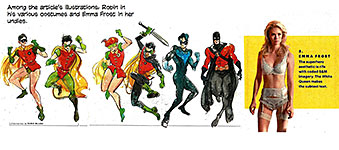

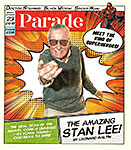
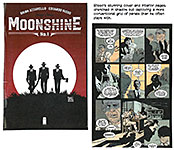
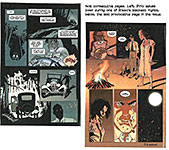
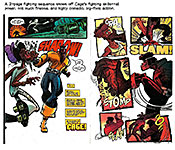
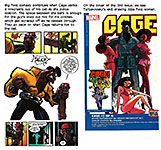
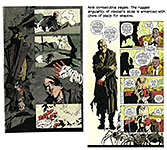
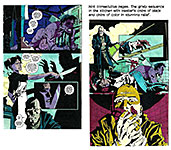
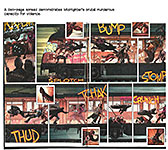
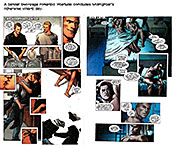
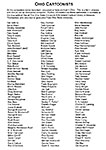
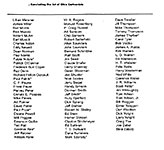
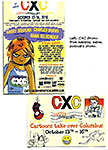

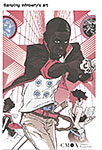
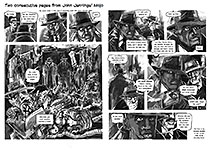
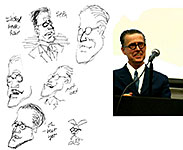
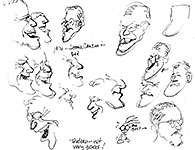
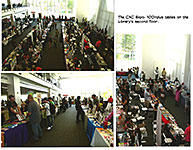

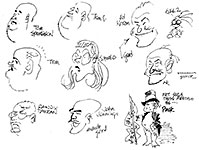

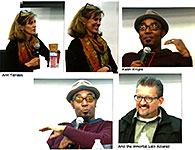
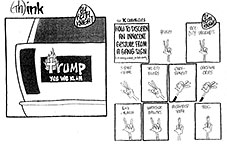
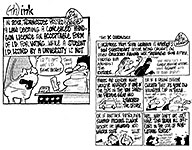

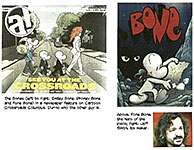
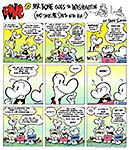
1xxx.jpg)
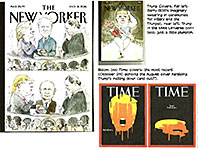
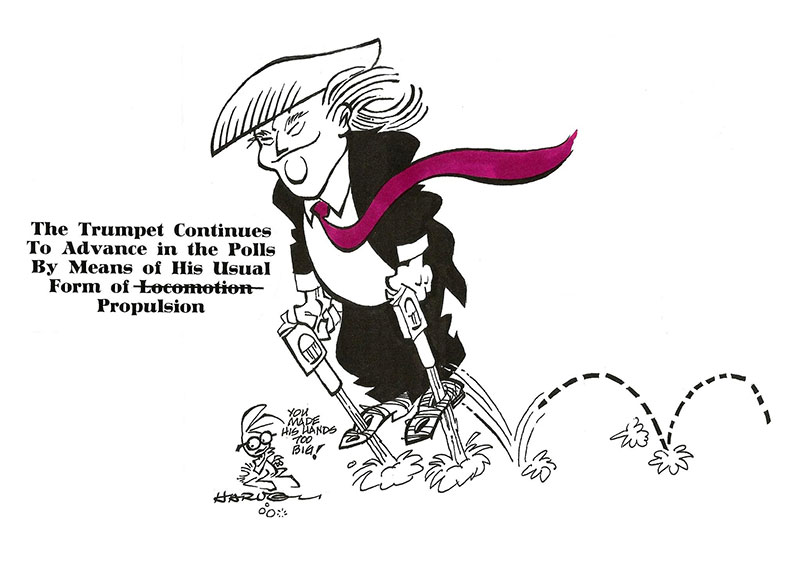
1.jpg)
2.jpg)
3.jpg)
4.jpg)
5.jpg)
6.jpg)
7.jpg)
8.jpg)
9.jpg)
10.jpg)
11.jpg)
12.jpg)
13.jpg)
14.jpg)
1.jpg)
2.jpg)
2a.jpg)
3.jpg)
4.jpg)
5.jpg)


